Glasgow was once Scotland’s dingy problem child. Today, however, the city is a worthwhile destination for visitors. Find out why here.

Info about Glasgow:
» Places of interest
» Shopping
» Accommodation
» Bus & Train
» Dialect
» History of the region
Glasgow was once regarded as the murder capital of Western Europe. But that has changed dramatically since the beginning of the new century. The former “problem child” Glasgow has now become Scotland’s most likeable city – not always beautiful and smooth, but honest and rough. This is exactly what makes Glasgow so authentic.
Glasgow is well worth a visit. To help you get your bearings, here are the most beautiful sights in the city in the west of Scotland. There is also information about the inhabitants and the dialect. Finally, there is an outline of Glasgow’s history, which in turn is closely linked to the city’s attractions. All of this is illustrated with many photos.
People: Scotland’s largest city has the friendliest inhabitants
The 2022 Census counted 620,700 inhabitants, an increase of around 27,000 people since the 2011 census, making Glasgow significantly larger than the capital Edinburgh with its population of around 492,680.
But Glasgow also still has an image problem, as it gained a reputation in the 1990s as a dirty city with a high crime rate. However, the city council is tackling this problem head on. The “People make Glasgow” campaign is working with many partners to promote a positive image. With success: a survey by Roughguides in the social networks named Glasgow the “friendliest city in 2014”.
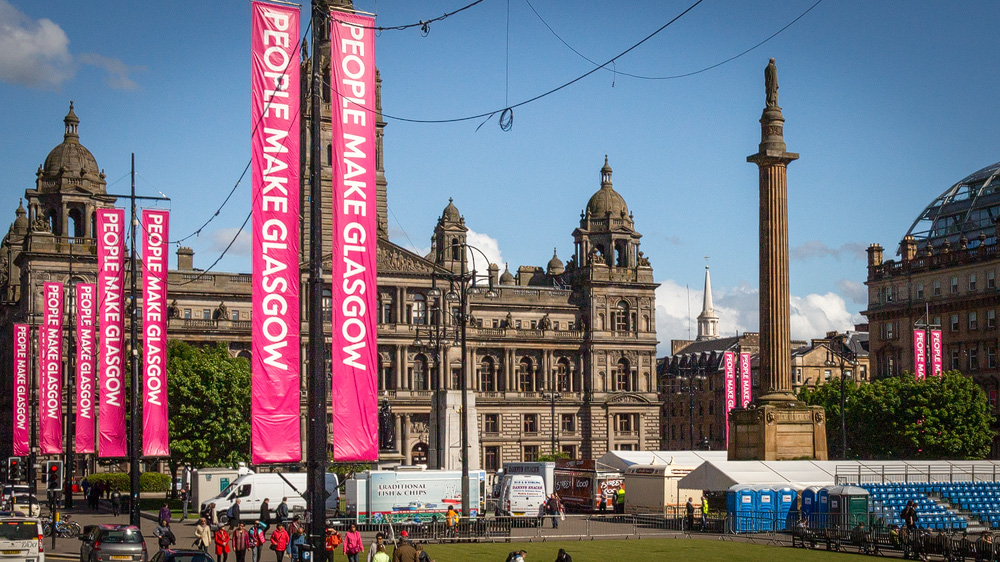
Incidentally, Glasgow also appears to be an Internet-friendly city: there is free WLAN access throughout the city centre, which sometimes works well, sometimes not so well.
Crime: Glasgow is still Scotland’s most dangerous city, but …
Although the image is improving and although visitors to the city centre can feel very safe, this negative side of Glasgow cannot be ignored.
In 2020, there was an average of 680 crimes per 10,000 inhabitants. Of these, 29 were serious physical assaults. By comparison, there were only 20 in Edinburgh, but none of this has anything to do with the violence of the 1990s. Overall crime in Scotland is currently at its lowest level for 50 years. In Glasgow, it has continued to fall, as ten years previously there were 1,029 crimes per 10,000 inhabitants. However, this violence mostly takes place between gang members in the outskirts of the city, where hardly any tourists stray.
Nevertheless, visitors should exercise a certain amount of caution – as in any big city. Overall, however, Glasgow feels very safe.
Music: UNESCO City of Music Glasgow
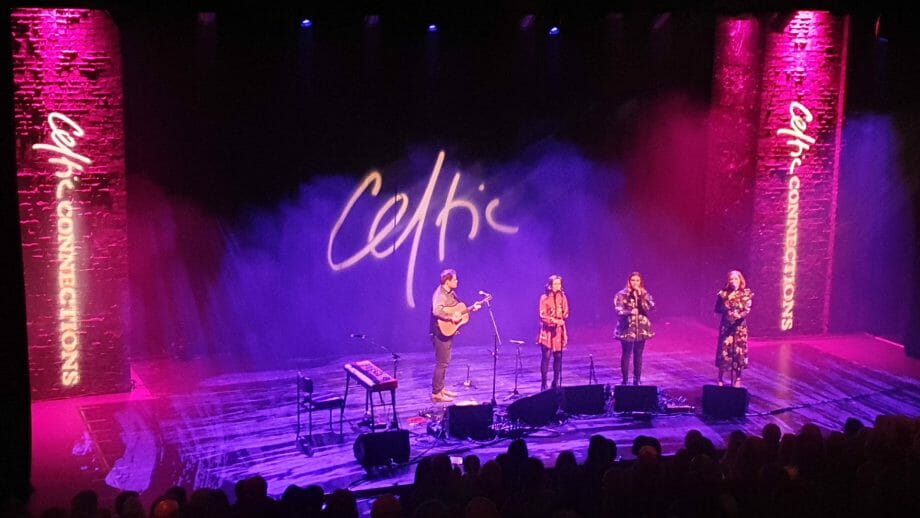
Glasgow is one of 19 cities worldwide to have been awarded the title “City of Music” by UNESCO. Visitors encounter bands and street performers almost everywhere and at all times. The city’s many stages, whether in pubs or in large venues such as the famous Barrowland Ballroom or The SSE Hydro, form the basis for this.
Music enthusiasts can book a tour with Glasgow Music City Tours. On a guided walk, they learn about the most important places in Glasgow.
Every January and February, Celtic Connections takes place regularly with hundreds of concerts celebrating Celtic music.
Places of interest: Glasgow’s history makes for impressive diversity
Throughout its history, Glasgow has experienced ups and downs that have left their mark on every era. And so Glasgow appears a little tougher and more scarred than Edinburgh, perhaps not quite as smooth and beautiful at first glance.
And yet Glasgow’s architecture is in no way inferior to that of Edinburgh. The mix is just a little strange. You will find old buildings from the 17th century, many from the Victorian era, right next to modern masterpieces.
Incidentally, some of Glasgow’s most beautiful buildings are home to museums and art collections. This is a second speciality of Glasgow: all of the city’s museums are free of charge.
Quick overview: The most important attractions in Glasgow
Here is a selection of what I consider to be Glasgow’s most important attractions, each with a picture. Incidentally, I have visited them all myself and the photos are also mine – and not from a picture portal.
Top attractions in Glasgow
- George Square & City Chambers
- Kelvingrove Art Gallery and Museum
- University of Glasgow
- Botanic Gardens
- Necropolis
- St Mungos/Glasgow Cathedral
- The Clydeside Distillery
- Riverside Museum and the Tall Ship
- Mackintosh at the Willow
- Gallery of Modern Art
- Glasgow Science Centre, SECC, the Armadillo and the Clyde Arc
- Glasgow Green and People‘sPalace
- The Hidden Lane
- The Tenement House
- Glasgow Murals
- Pollock House and Gardens
George Square and the Glasgow City Chambers
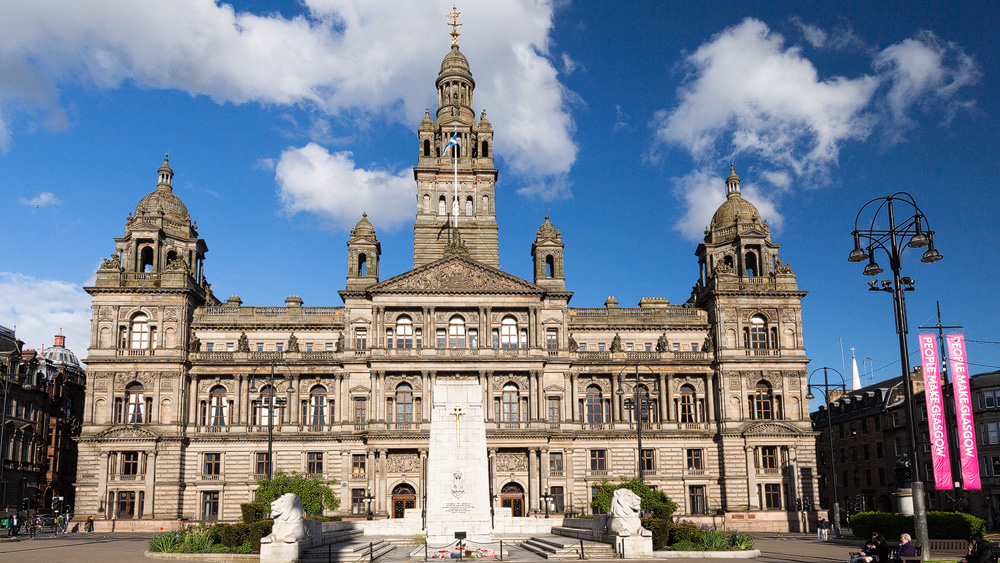
George Square marks the centre of Glasgow. Right next to it is Queen Street Station and therefore also an important local transport centre. Almost all buses pass George Square, which is bordered by four busy streets. An excellent place to start exploring the city! The city sightseeing buses also depart from here.
The Glasgow City Chambers, the city’s town hall, are located at the west end of George Square. If you think the exterior is bombastic, you should take a look inside first. The vaulted ceiling and floor are decorated with mosaics – over 1.5 million tiles were used in total. Columns made of granite support the sky and the staircase is lined with lavish marble. Tours are organised twice a day, giving visitors a glimpse into rooms that are otherwise closed.
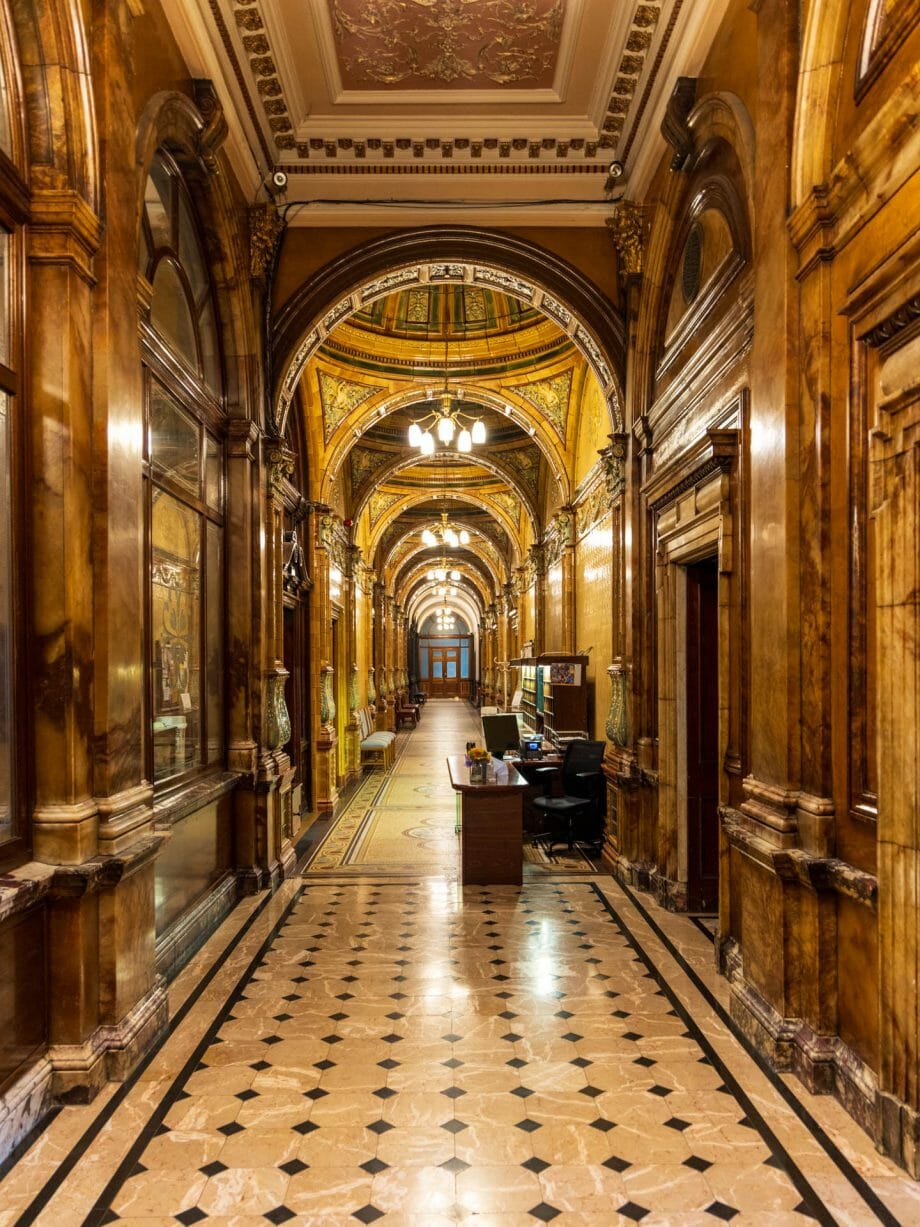
👉 TIP: The tour cannot be pre-booked. So get there half an hour early and pick up your ticket. First come, first served – no more than 25 people are allowed on the tour. If you miss it: Anyone can see the lower section and it’s impressive in itself.
More information and pictures of the City Chambers can be found here in the article.
Opening hours:
Mon-Fri 08:30 – 17:00
Tours at 10:30 and 14:30
Admission: free, free tour
Web: www.glasgow.gov.uk/article/19136/City-Chambers-Tours
Kelvingrove Art Gallery and Museum
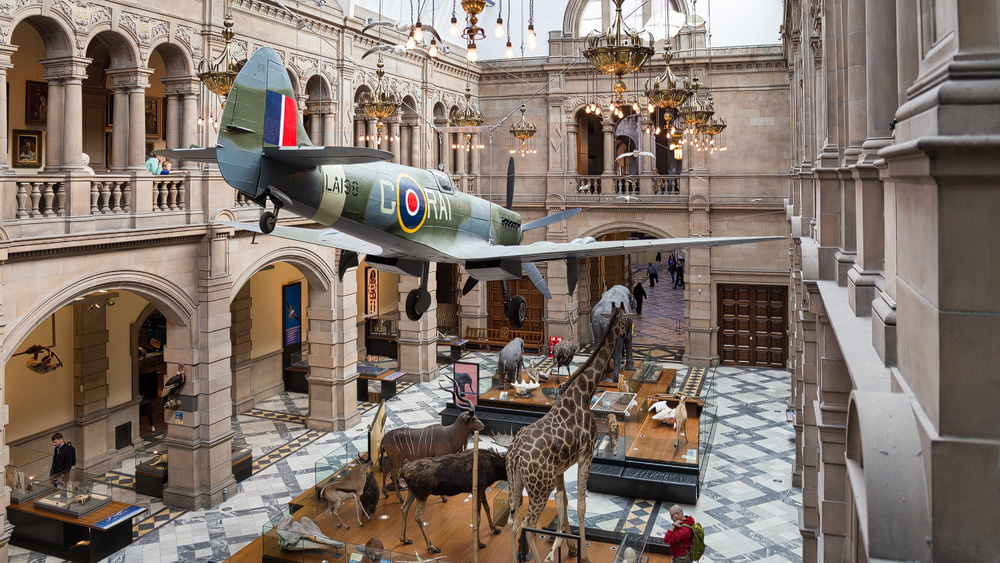
Wow on the outside … inside too! Kelvingrove has an impressive red façade and inside there are marvellous halls with great chandeliers and interesting exhibits. There is something for everyone: art, technology and nature. Highlights include exhibits by Charles Rennie Mackintosh and his contemporaries. The history of Scotland is also interesting.
And here too, as with all of Glasgow’s public museums: Admission is free.
More information about Kelvingrove Art Gallery and Museum here.
Opening hours:
Mon-Thu, Sat: 10:00 – 17:00
Fri, Sun: 11:00 – 17:00
Admission: free
University of Glasgow
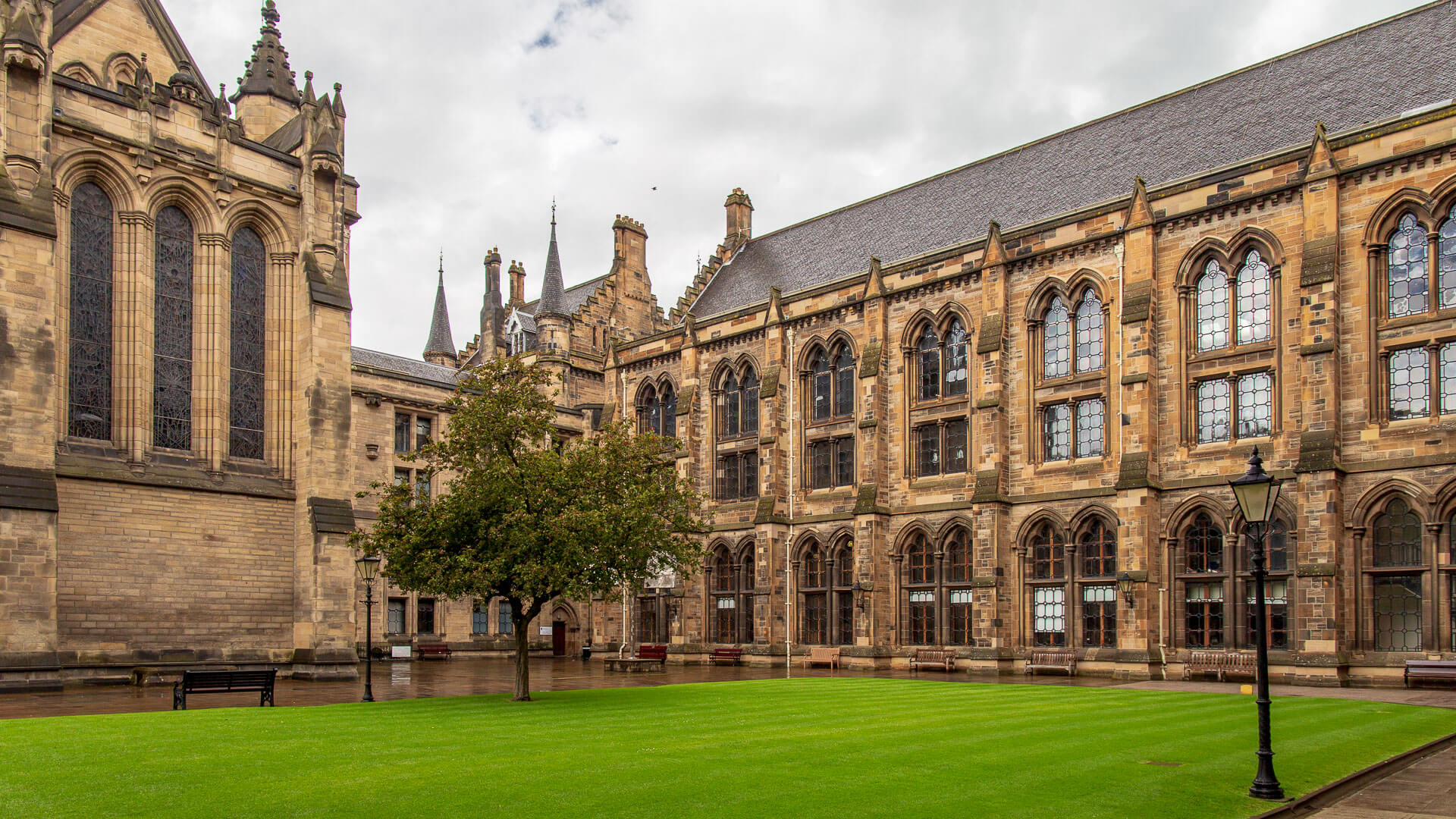
The second oldest university in Scotland (after St Andrews) has been in existence since 1451 and has grown over the centuries to become a feast for the eyes. You can wander around the campus or take part in a guided tour. The Cloisters are particularly beautiful to look at. “Cloister” in itself is a monastic cloister. As the supporting pillars under one of the buildings look similar, this area bears this nickname.
The university has the beautiful Bute Hall, which is only rarely open to the public. The Hunterian Museum in the university is free to visit, and its hall and exhibits are also beautiful. Opposite the main building across the street are other exhibitions, including the Charles Rennie Mackintosh House, which is characterised by its special Art Nouveau interior.
Tours: Tue – Sun 14:00
Participation:
Adults: £10
Concessions: £8
Teenagers: £5
Children under 5 free
Families: £25
Botanical Garden
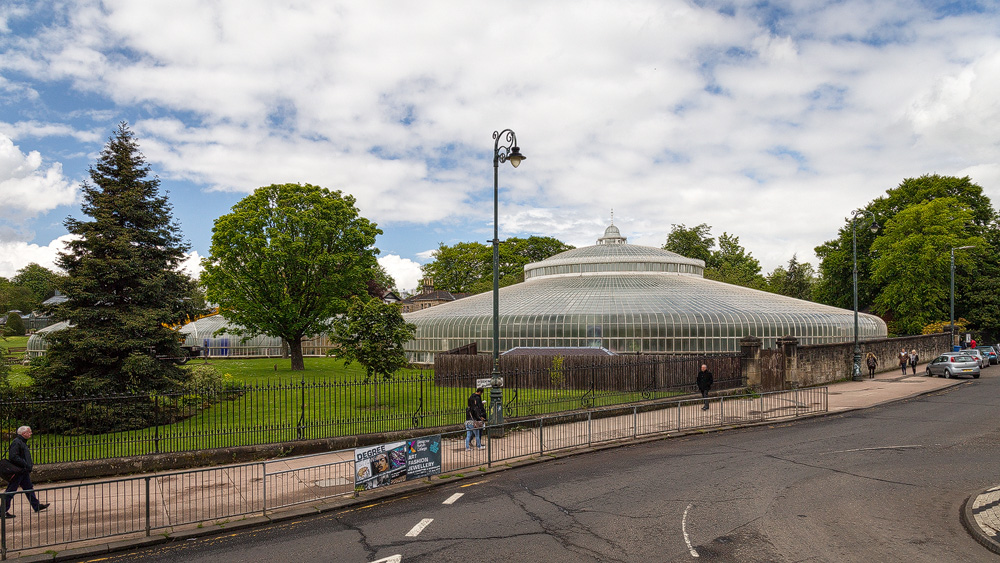
The Glasgow Botanic Gardens were founded back in 1817. Since then, gardeners have been collecting plants of all kinds there. By 1873, John Kibble had built the unique Victorian glass structure that can be seen today. There are also other large greenhouses with many exotic plants such as orchids. Outside, there is a rose garden and a herb garden. And here, too, admission is free!
More about the Glasgow Botanic Gardens here.
Opening hours:
Outdoor garden:
daily 07:00 – sunset
Greenhouses:
daily 10:00 – 18:00 (summer)
daily 10:00 – 16:15 (winter)
The Necropolis
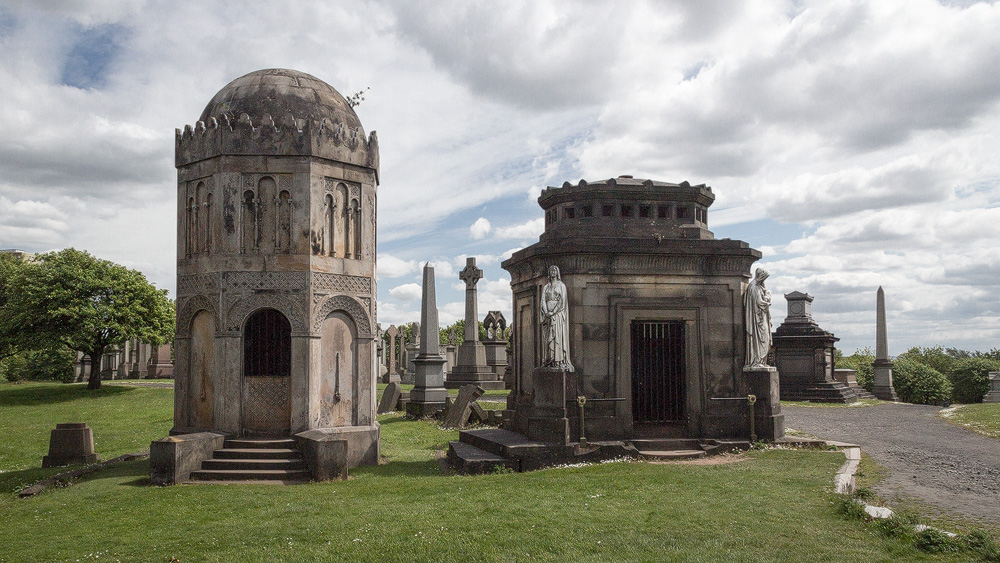
Glasgow’s city of the dead is home to 50,000 (former) citizens. The wealthiest of these have been immortalised in magnificent tombs. Elaborate mausoleums and richly decorated gravestones with statues alternate here. Particularly impressive: the so-called Bridge of Sighs leads to the former underground entrance.
More details in the detailed article here.
Opening hours: last admission 4 pm
Admission: free
St Mungos/Glasgow Cathedral
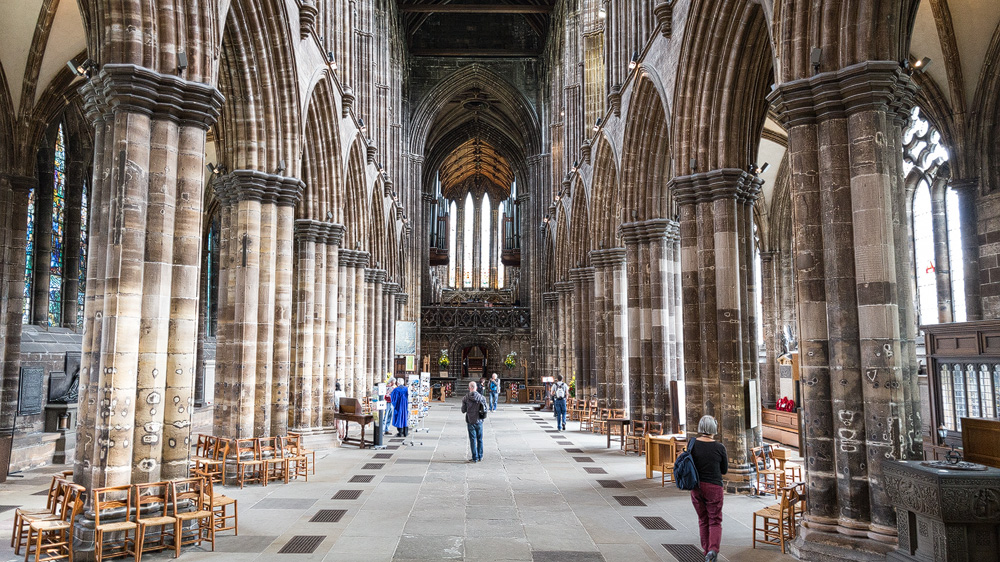
Right next to the Necropolis is the magnificent cathedral of the city’s founder, St Mungo. The interior of the 800-year-old building is well worth seeing. A wooden vault with many coats of arms spans the choir. Stained glass windows and carved altars adorn the stone pillars and arches. Particularly interesting: the tomb of the city’s founder, St Mungo, in the crypt.
More information in this article.
Opening hours:
Apr-Sep:
Mon-Sat: 9:30-17:00
Sun: 13:00-16:30
Oct-Mar:
Mon-Sat: 10:00-15:30
Sun: 13:00-15:30
Admission: free
The Clydeside Distillery
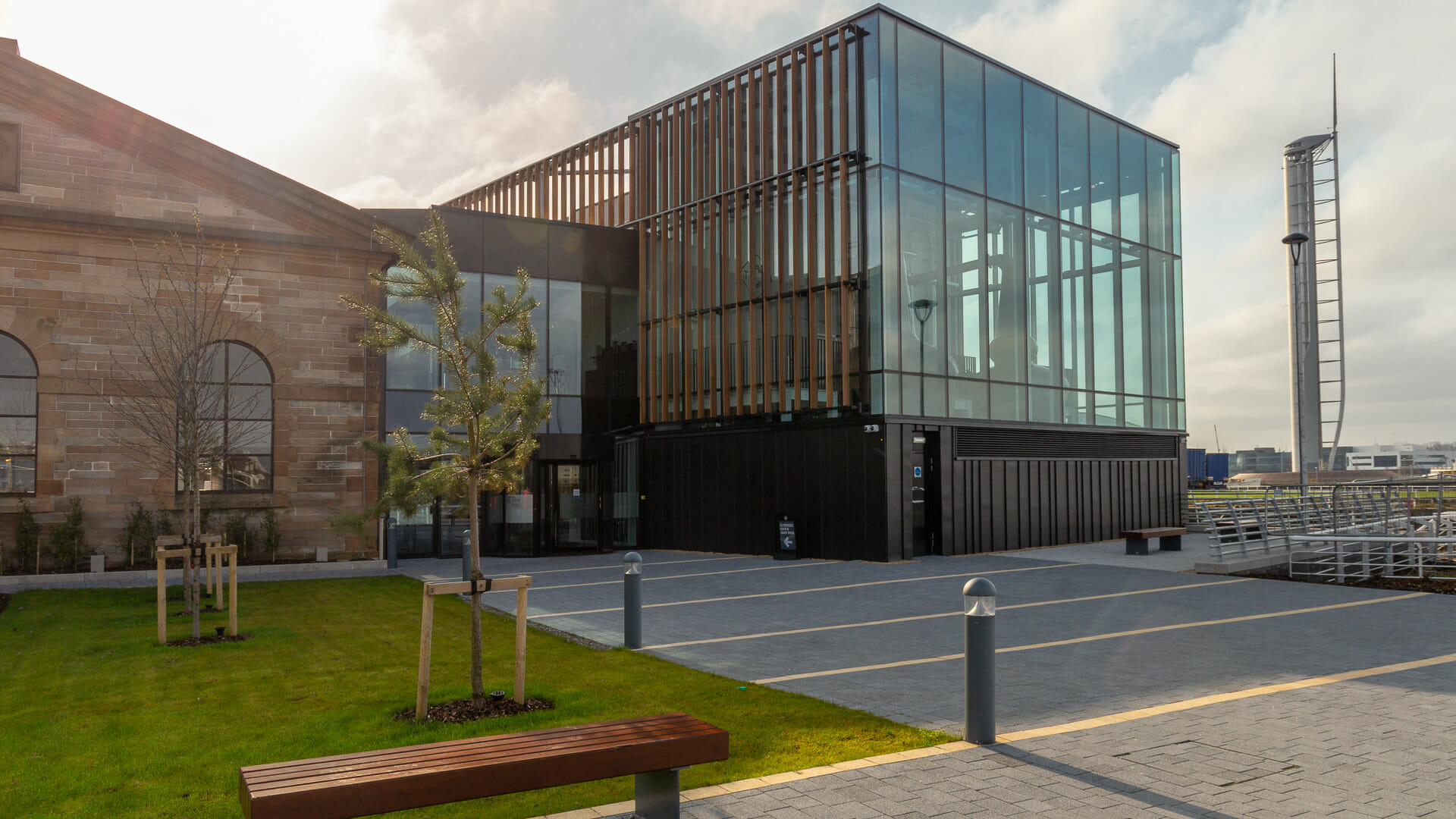
Located directly on the River Clyde, a few hundred metres from the Riverside Museum, The Clydeside Distillery is still very young. This single producing distillery was only completed in 2017, which is why there is no finished single malt whisky yet, only “new make spirit” or bottlings from other distilleries. However, the tour is interesting, the building is impressive and the subsequent tasting of three whiskies from different regions is delicious.
More information in this article.
Opening hours:
Mon-Sun:
10:00-17:00
(last tour 16:00 or 16:30 during July & August)
Admission:
Adults: £15
Concessions: £13
Children (8-17): £5
Families: 33 pounds
Riverside Museum and the Tall Ship
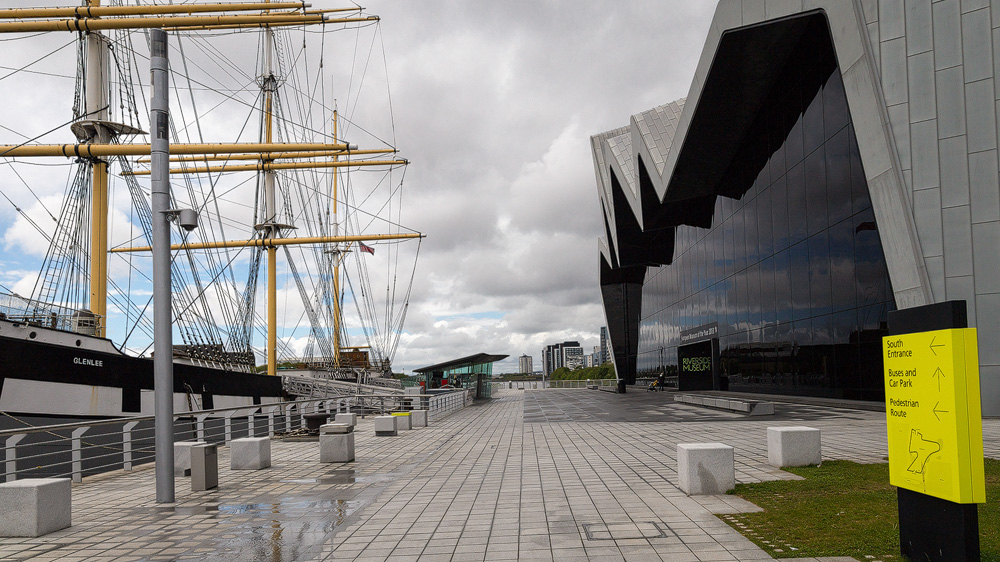
The latest architecture on the River Clyde: the Riverside Museum mainly exhibits the history of transport. But it also includes pushchairs and toys, for example. In addition, entire streets of old Glasgow have been recreated. A highlight is located in front of the building on the river: the Glenlee is a huge sailing ship that has travelled around the world several times. Visitors can come on board for free and marvel at the ship from the outside and inside.
More information in this article.
Opening hours:
Mon-Thu, Sat: 10:00 – 17:00
Fri, Sun: 11:00 – 17:00
Closed on Christmas, 1 and 2 Jan
Closed on New Year’s Eve from 13:00
Admission: free
Mackintosh at the Willow
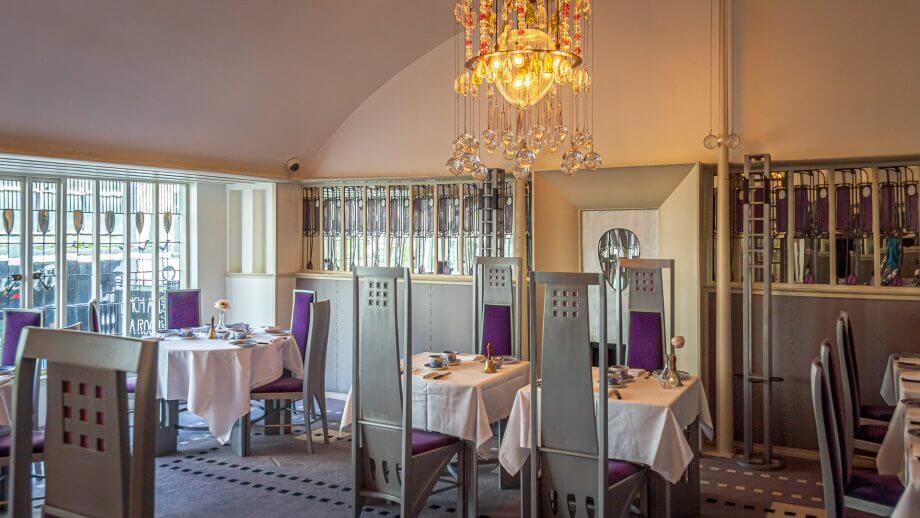
A cup of tea, an etagere with fine pastries, a magical atmosphere – the tearooms at Mackintosh at the Willow are some of the most beautiful things Glasgow has to offer. The interior was designed by the power couple Charles Rennie Mackintosh and Margaret MacDonald Mackintosh. For decades, this ornate teahouse sank into oblivion until its condition became lamentable. A few years ago, however, it was extensively restored. Today there is a visitor centre, guided tours or simply the opportunity to stock up on tea, coffee and biscuits.
More information on why Mackintosh at the Willow is so great can be found here.
Gallery of modern art
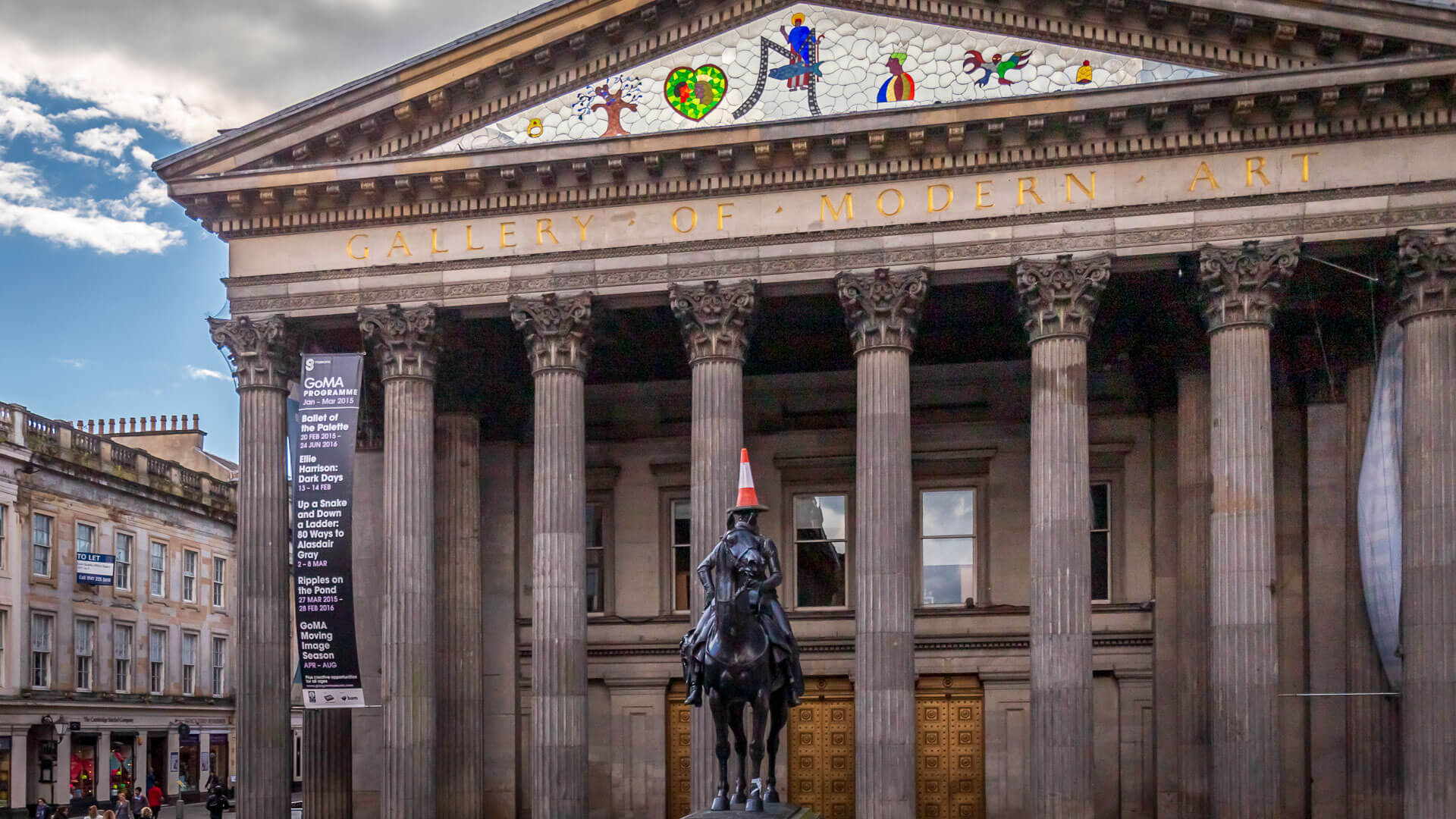
The GoMA, as it is known for short, is located in the centre of Glasgow. In front of it stands a statue of the Duke of Wellington, usually wearing a traffic cone – it is already clear that respect for conservative art is not appropriate here. And the inside of the gallery confirms it: modern art in changing exhibitions. And again, admission is free.
Opening hours:
Mon – Wed, Sat: 10:00 – 17:00
Thu: 10:00 – 20:00
Fri, Sun: 11:00 – 17:00
Admission: free
Glasgow Science Centre, SECC, the Armadillo and the Clyde Arc
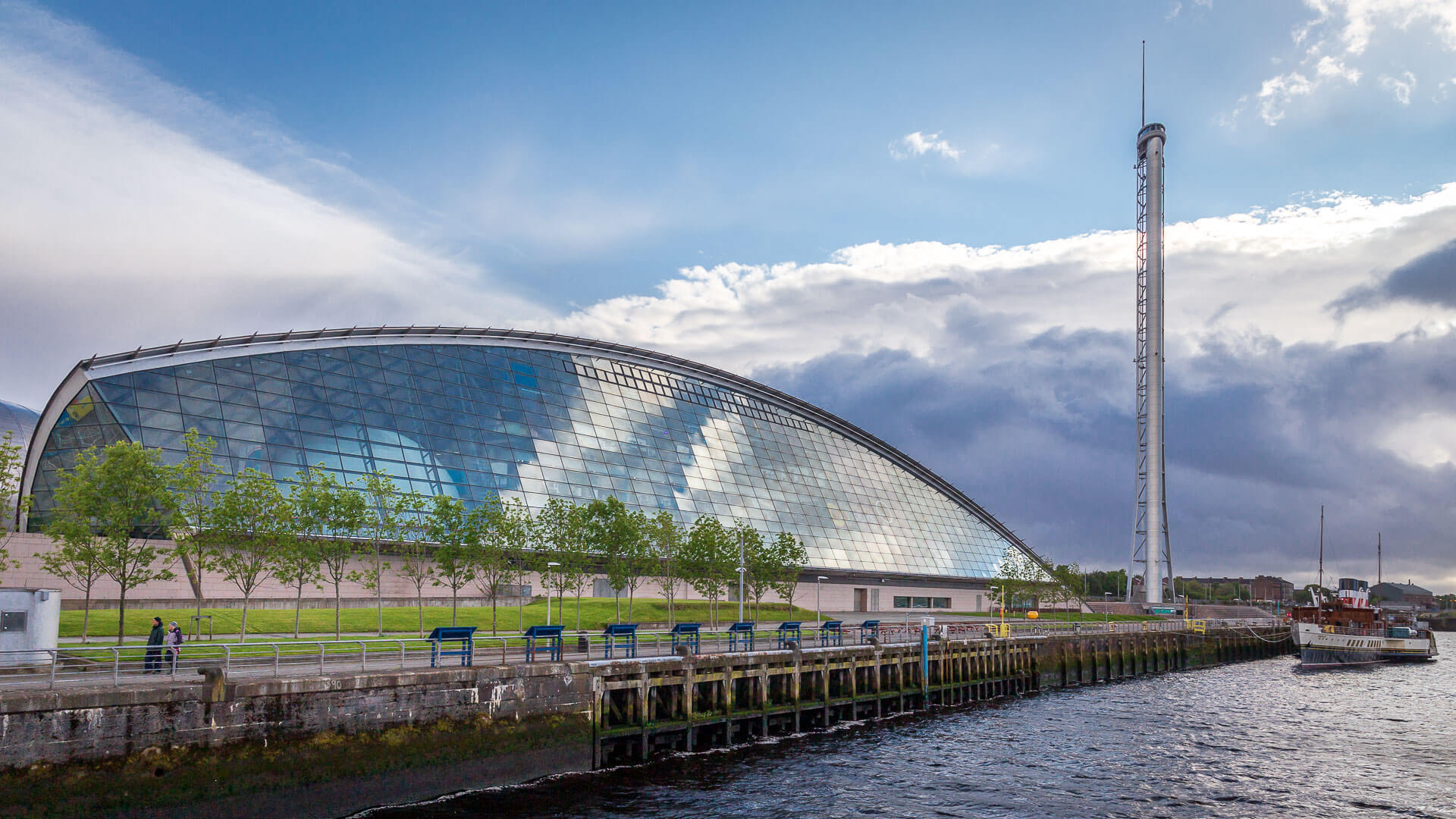
The Glasgow Science Centre building looks like a slice of lemon on a schnitzel. The modern building is located directly on the River Clyde in the west of the city, where visitors can explore the effects of scientific discoveries – mostly with fun toys. The Science Centre is therefore also suitable for children. Right next to it is the largest completely swivelling tower and the IMAX cinema. Admission is free.
It is definitely worth taking a walk along the Clyde afterwards, as modern architecture such as the SECC, the “Armadillo”, the gigantic Finnieston Crane and the “Clyde Arc” bridge are concentrated here. All of this can be seen as a picture at the top of this page.
Opening hours:
Summer (Apr – Oct)
Mon – Sun: 10:00 – 17:00
Winter (Nov – Mar)
Wed – Fri: 10:00 – 15:00
Sat, Sun: 10:00 – 17:00
Admission: free
Glasgow Green and People’s Palace
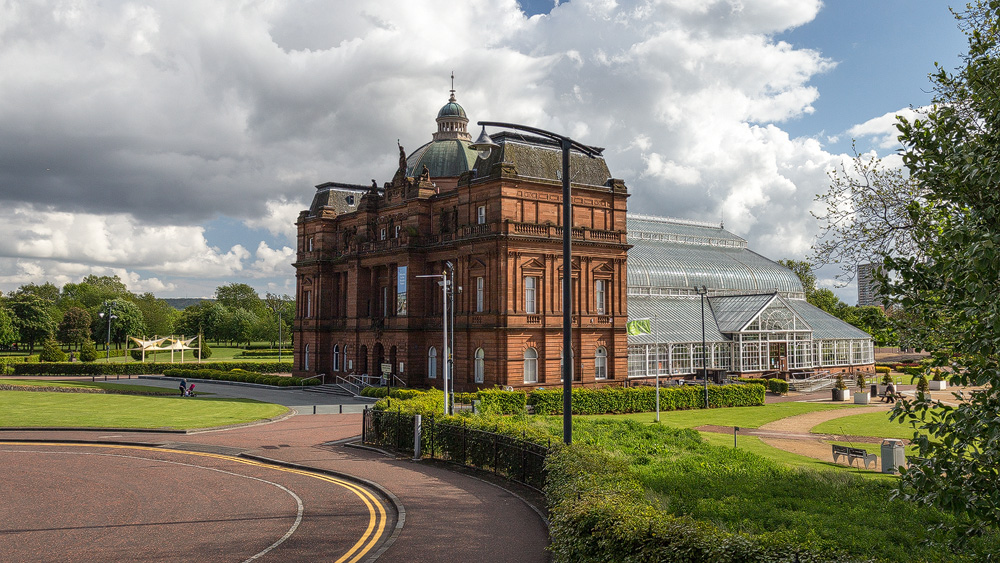
Please note: The People’s Palace will close its doors between April 2024 and 2027 for extensive renovation work. The green will of course remain open, and the sprinkler fountain, the exterior view of the building and the carpet factory opposite are still worth a visit.
A palace for the people in a park in the centre of the city. Glasgow Green dates back to the 15th century, the People’s Palace was opened in 1898 and was intended to be a cultural centre for Glasgow’s east end. Today it houses a museum showing life in the past, a garden under a marvellous glass structure with a café. Entry to the People’s Palace and its museum is free for visitors.
More information about Glasgow Green and the People’s Palace can be found here.
Opening hours:
Mon-Thu, Sat: 10:00 – 17:00
Fri, Sun: 11:00 – 17:00
Admission: free
The Hidden Lane
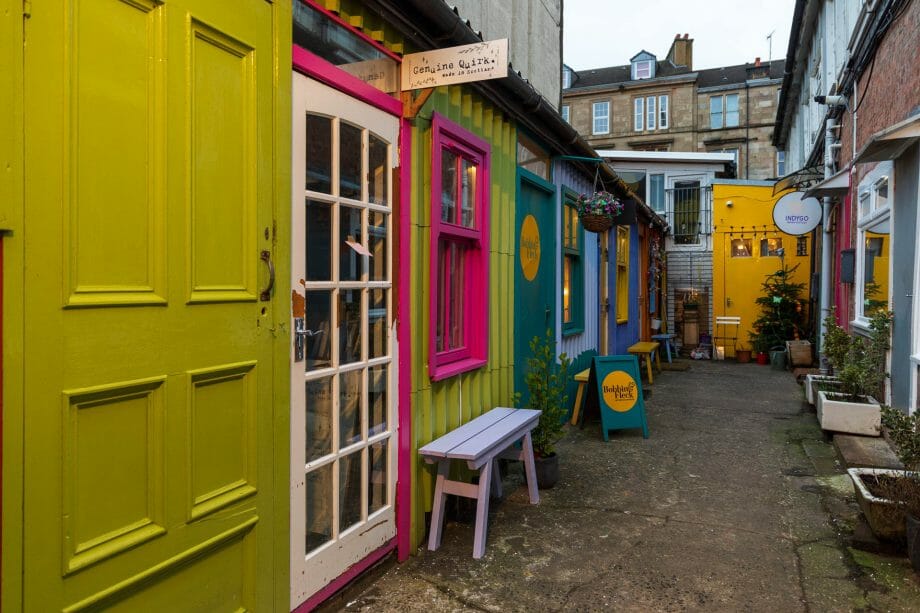
The passage to Hidden Lane is easy to miss. It leads off Argyle Street in Finnieston (look for number 1103). Behind the passageway is an area of colourful stone houses. Inside you will find a brewery, an antique shop, a record shop, a delicious café/tea house and many artists.
Read more about Hidden Lane here.
The Tenement House
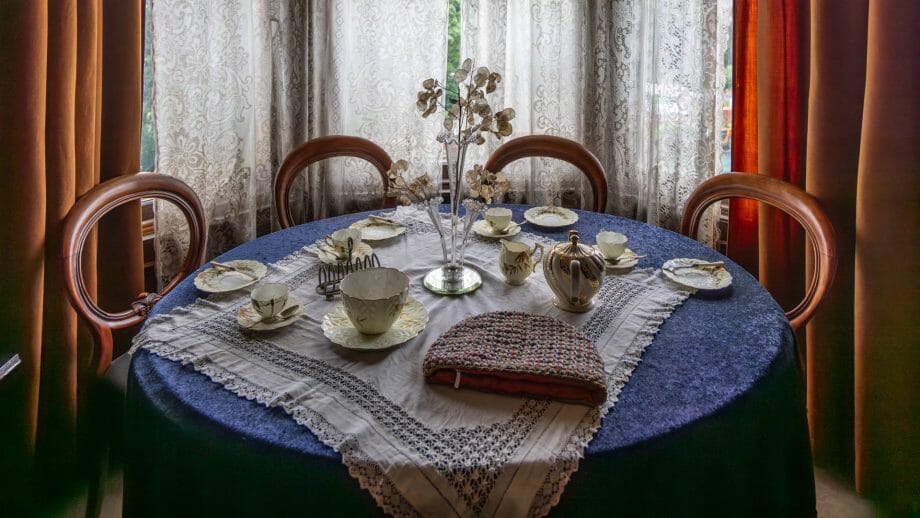
This flat has defied every change. A stroke of luck! Today it is one of the few places in Glasgow where a glass light still burns. The interior shows the living situation at the turn of the last century. A great insight into the lives of ordinary people in Glasgow around 1900, and a great change of pace on a rainy day.
More details can be found here.
Opening hours:
Mon-Sun:
daily: 10:00-17:00
(last admission 16.30)
Admission:
Adults: £8.50
Reduced: £6.00
Family: £20.50
Family (1st adult): £14.00
(as of 2023)
Glasgow Murals
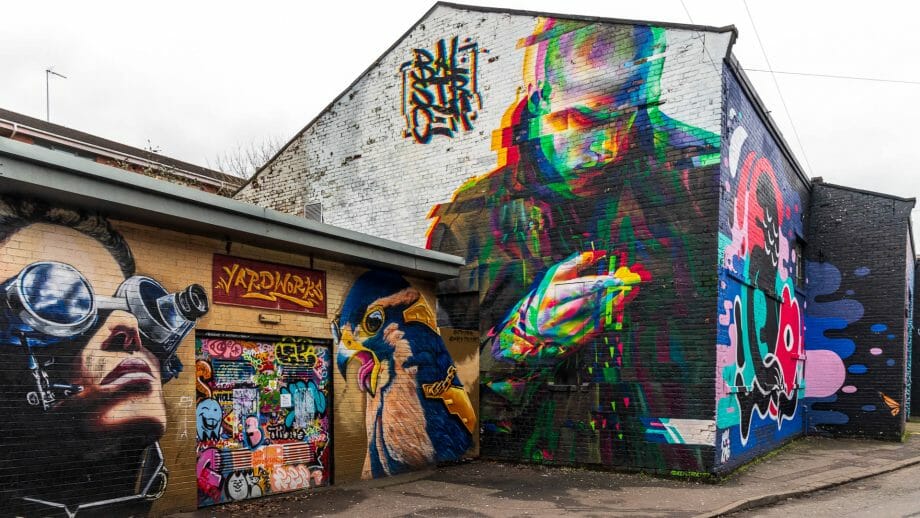
Murals are wall paintings and Glasgow is full of this wonderful modern art. Some are highly official and cannot be removed, others are temporary and disappear again. Almost all are worth seeing. In many cases, the city itself supports the artists with money.
The murals can be discovered in passing on normal walks. However, if you are interested in this art in particular, you can hike the official Glasgow Mural Trail.
Pollock House and Gardens
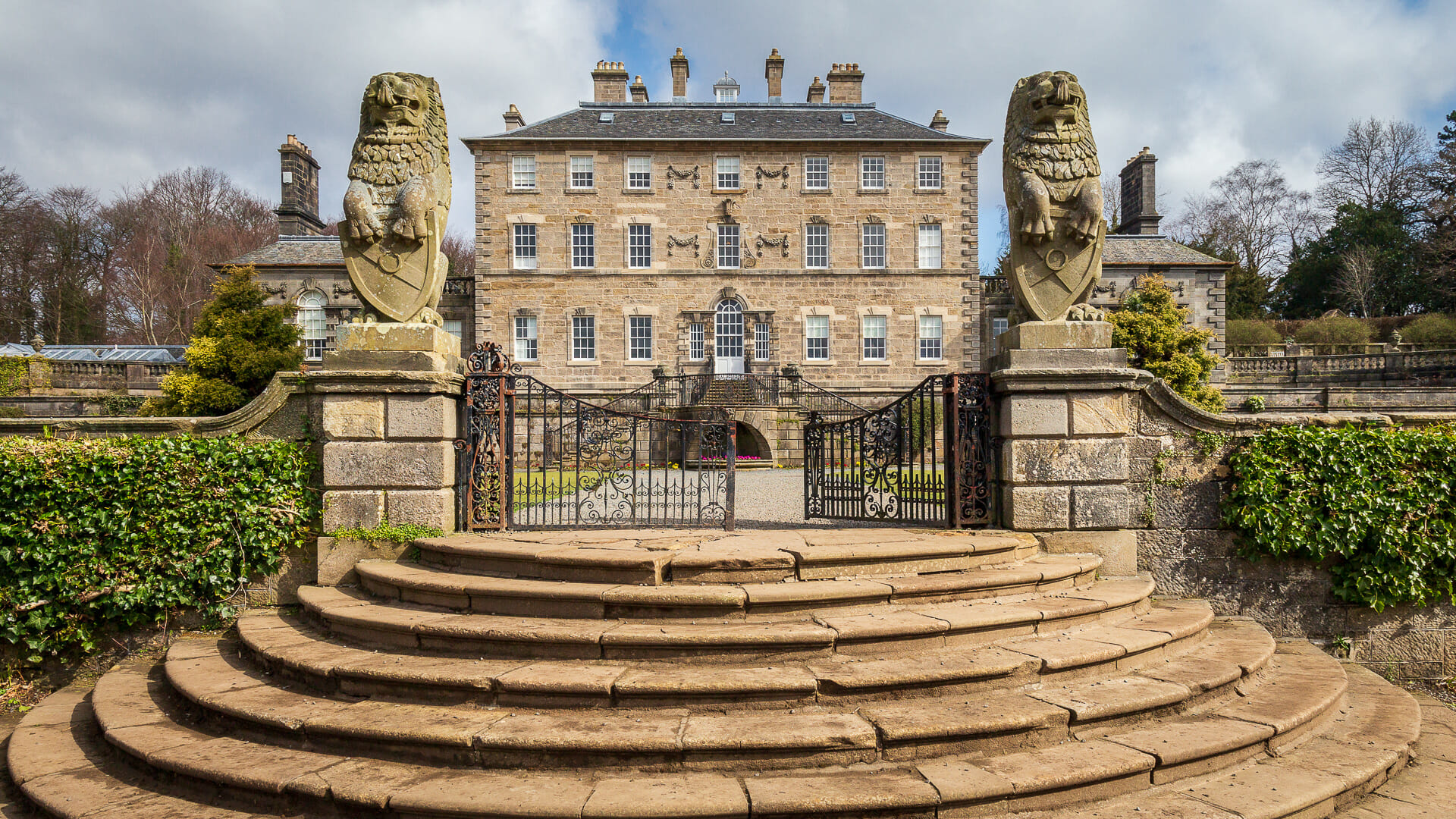
Pollock House is located on the south-western outskirts of the city. The house has marvellous rooms with old and expensive furnishings. The paintings in the house are often old Spanish masterpieces. The house is surrounded by a beautifully manicured garden and a huge park, which was also used as a film set in the Outlander series.
More information about Pollock House can be found here.
Opening hours
daily: 10:00 – 17:00
last admission 16:30
Admission fee:
Adults: £8.50
Family: £20.50
Family (one adult): £14.00
Concessions: £6.00
City Centre Contemporary Art Trail
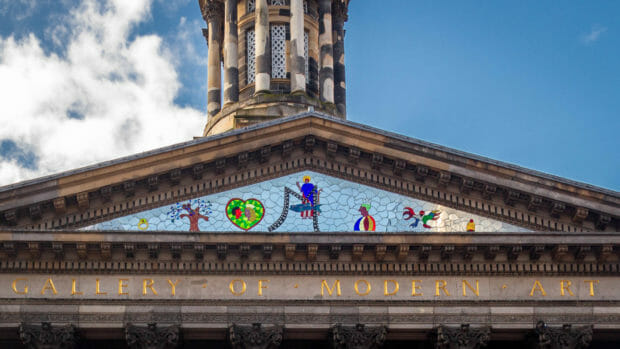
Glasgow displays modern art in many places around the city. 14 of these works of art can be discovered on foot in the city centre on the City Centre Contemporary Art Trail. The tour takes around one and a half hours.
More information and a map can be found on the Contemporary Art Trail website.
***
OF COURSE these are not all the attractions, but just a few that are available in Glasgow. I would be delighted if you could write in the comments what you liked best if you have ever been to Glasgow.
Shopping tour: Shopping in Glasgow
Of course, there are good shopping opportunities in the city centre from George Square onwards. One of the shopping streets is Buchanan Street, which is also home to the Buchanan Quarter and the Buchanan Galleries.
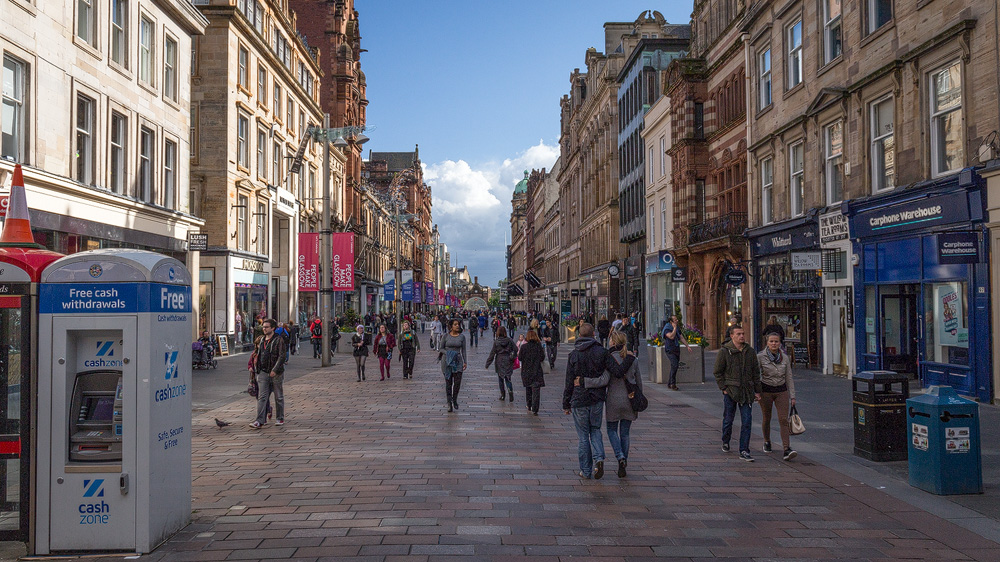
Buchanan Street runs between two large shopping centres. Ennoch Square is adjacent to the large shopping centre of the same name.
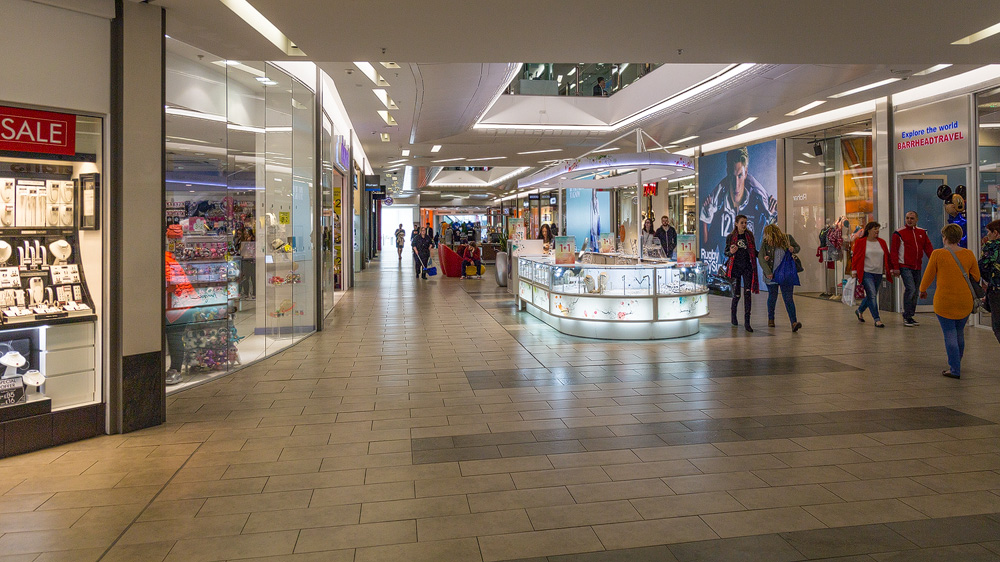
At the other end, the Buchanan Galleries, with the Royal Concert Hall inside.
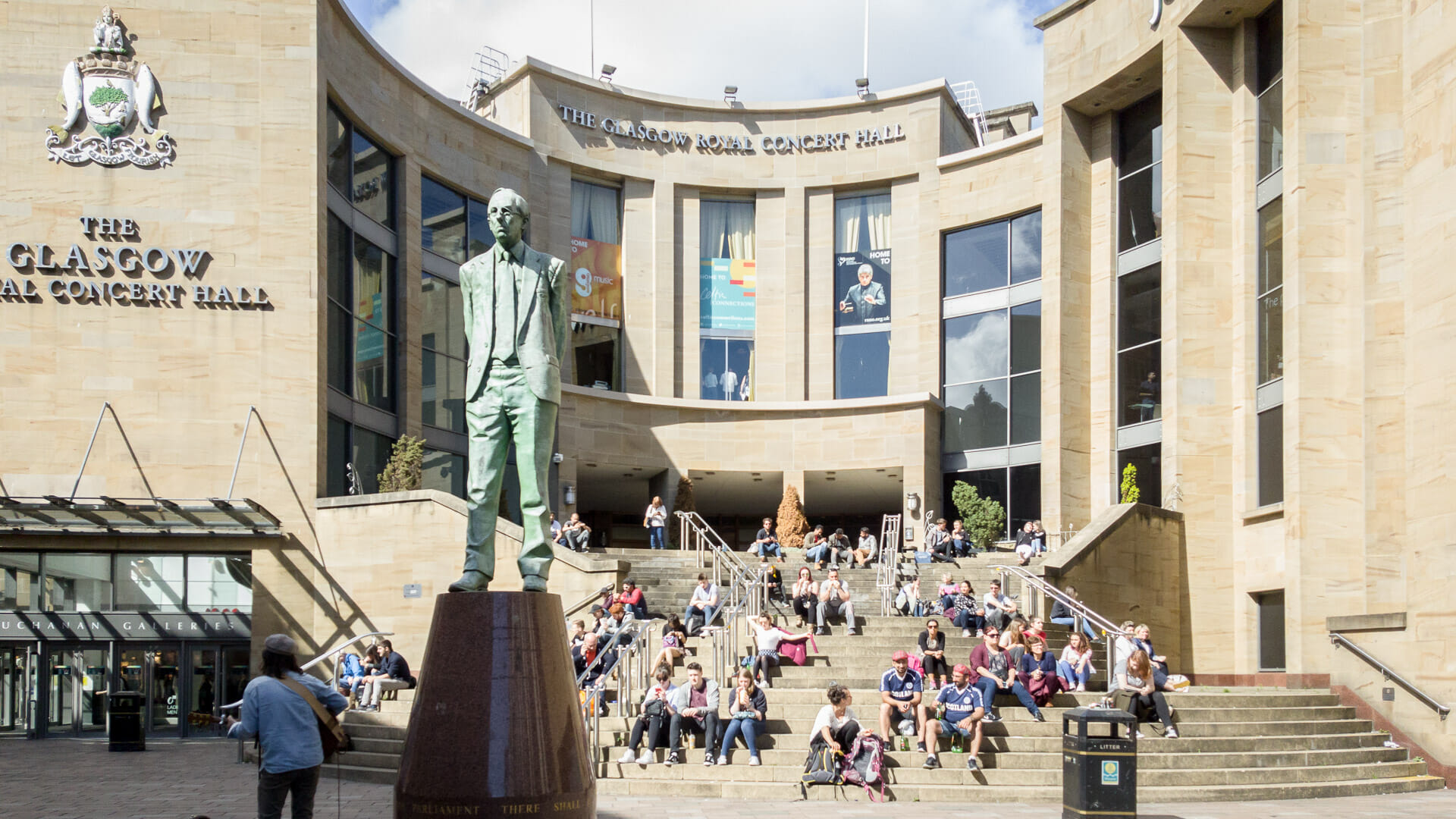
Alternatively, you can head to Byres Road in the west of the city. It not only has shops, but also bars and restaurants.
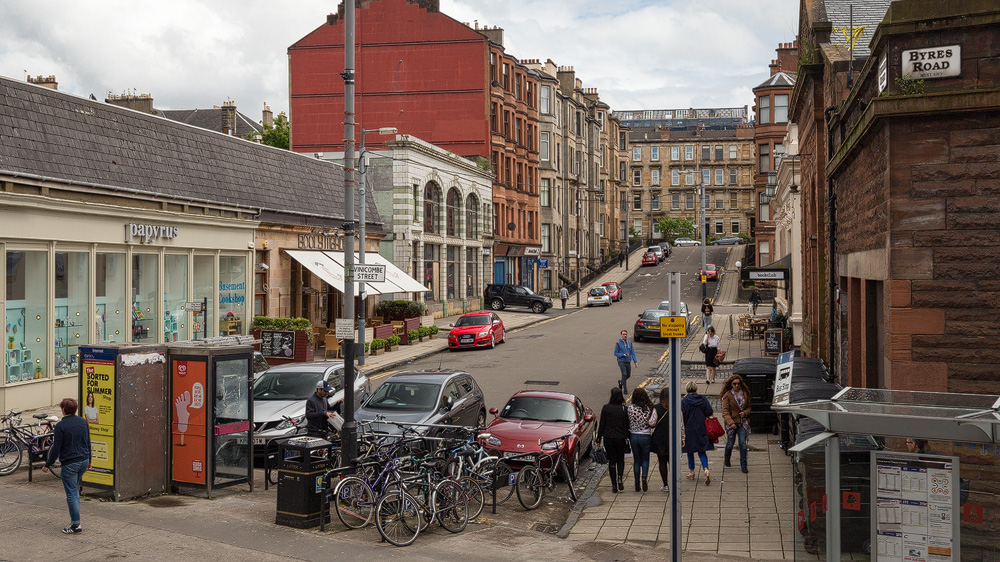
At the northern end of Byres Rd, on the corner of Great Western Road, is Oran Mòr, a converted church that now houses a more upmarket pub. It offers live music, good food and affordable whisky. As a result, it can sometimes be quite full. But we have also enjoyed it almost empty on a Sunday evening.
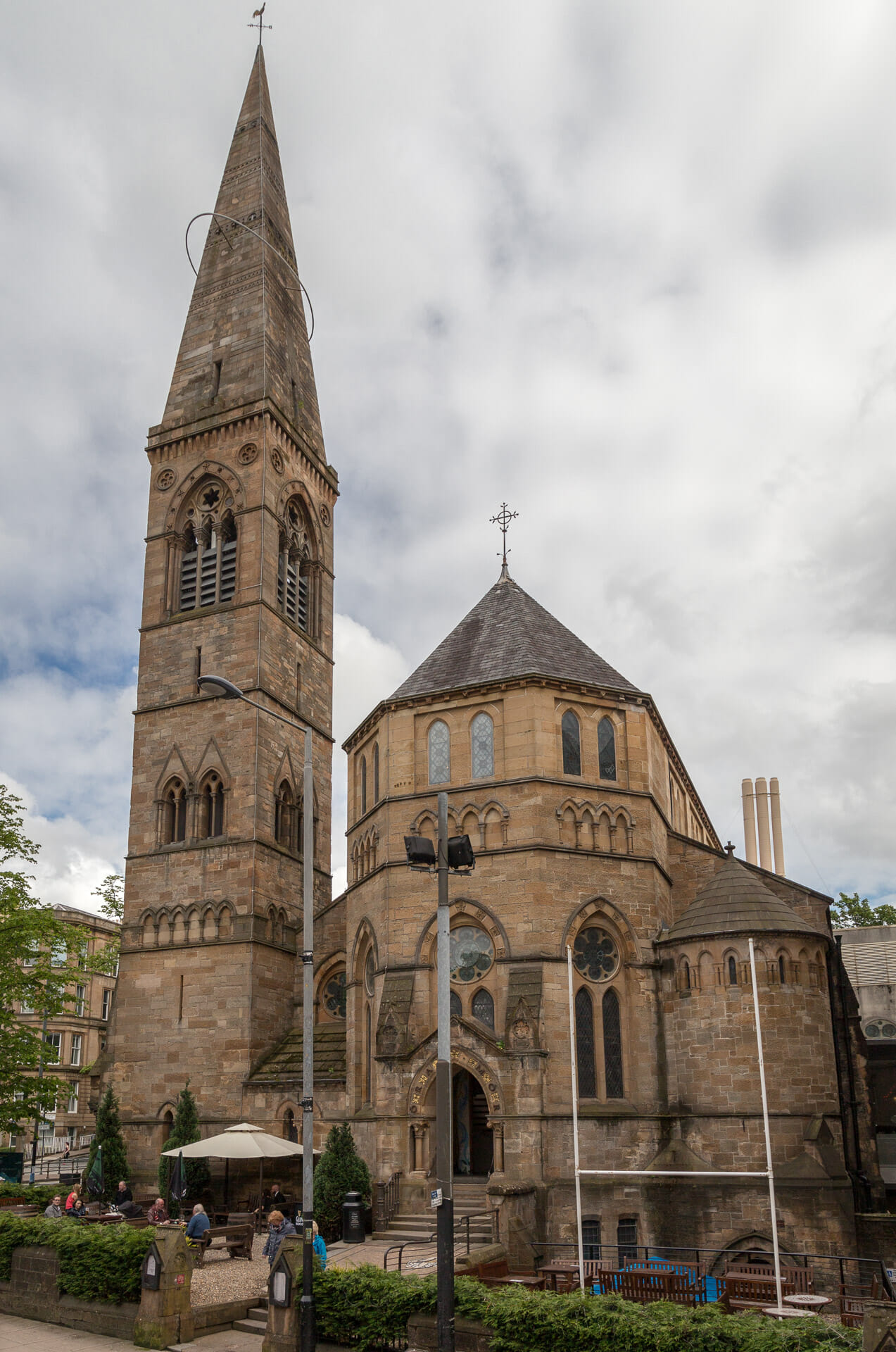
In my opinion, the time-honoured Barras market, which is still a stop on city tours, is hardly recommendable. While it was still interesting and worth seeing a good 20 years ago, I now find it repulsive. There is more rubbish there than goods.
Update 2023: The facades on site have been repainted. The situation may have improved, I’ll check that next time I visit the market.
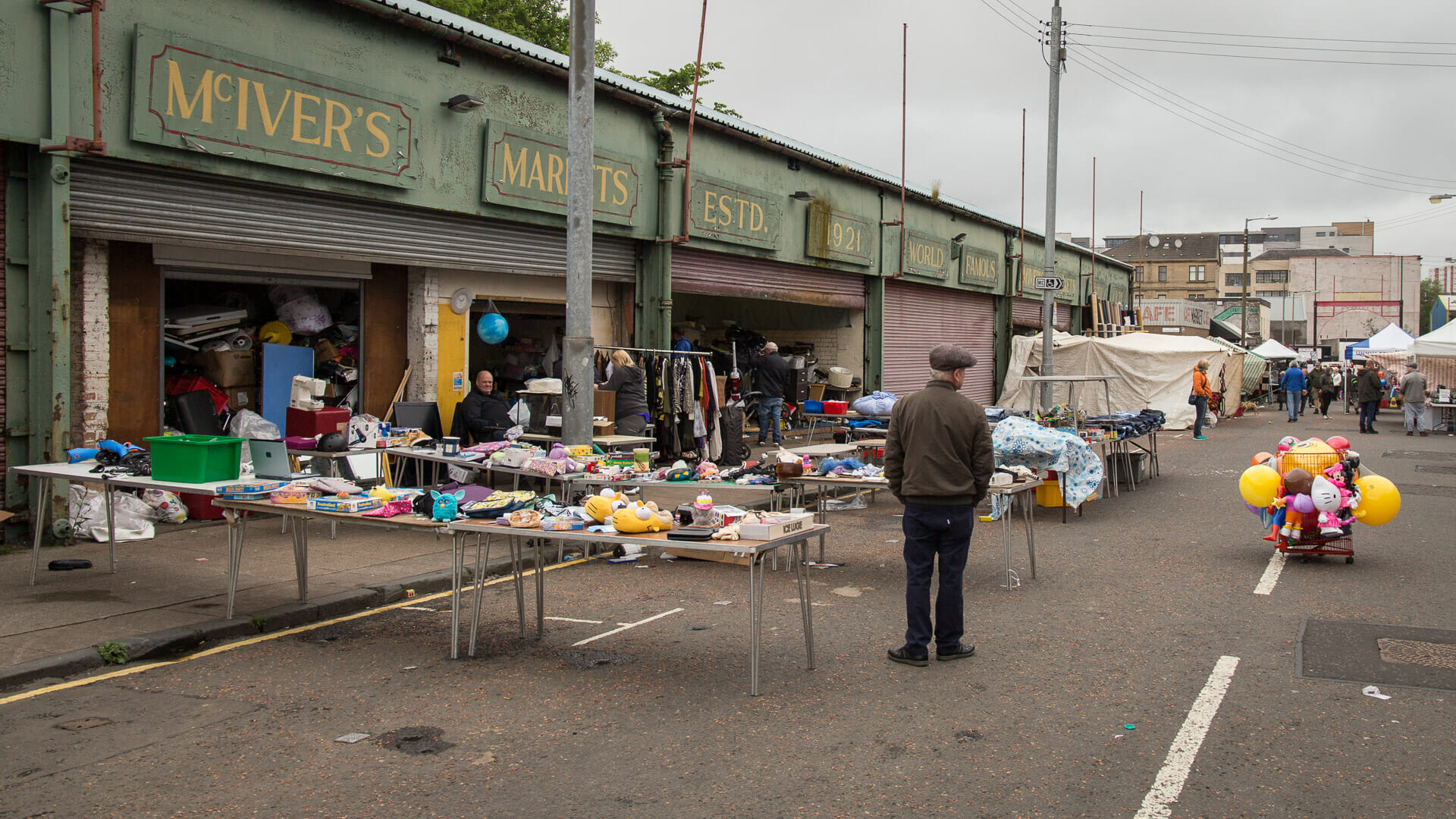
Accommodation in Glasgow
I have already stayed here:
Motel One Glasgow
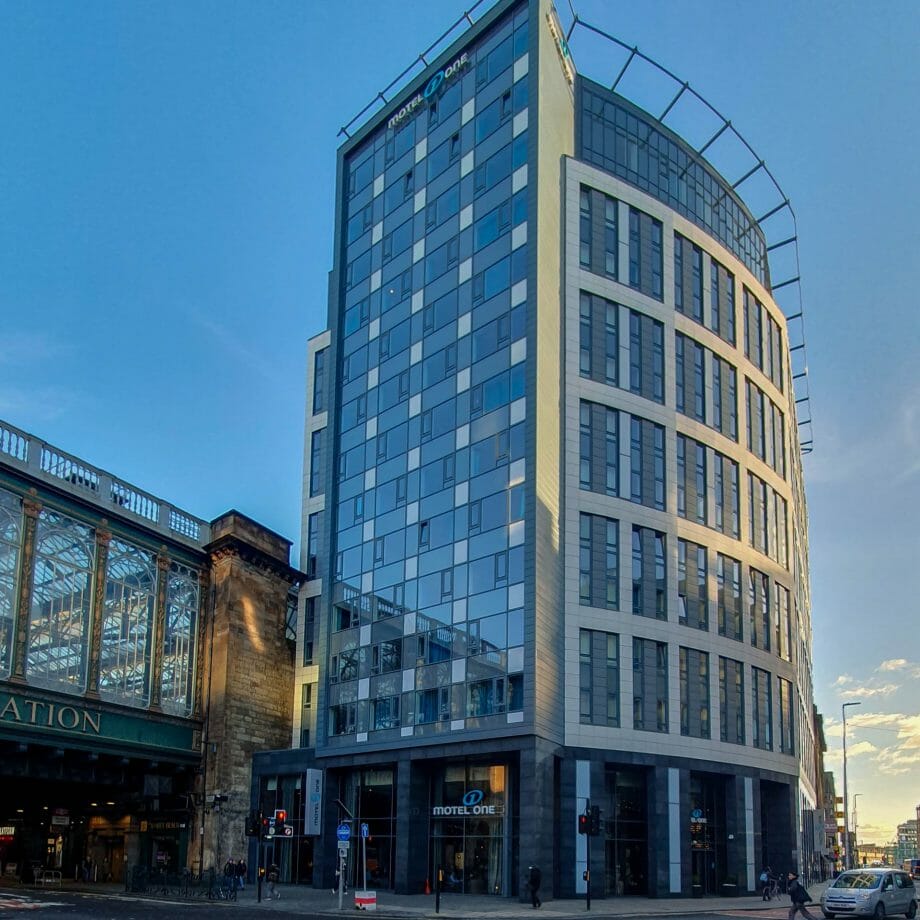
I admit it: I feel at home in Motel One hotels. This one is right in the city centre by the main train station. It’s about a 15-minute walk to George Square and the pedestrian zone is just around the corner. The hotel opened in 2022 and is in the mid-price segment.
Here to Motel One Glasgow (Advertising)
Alamo Guest House
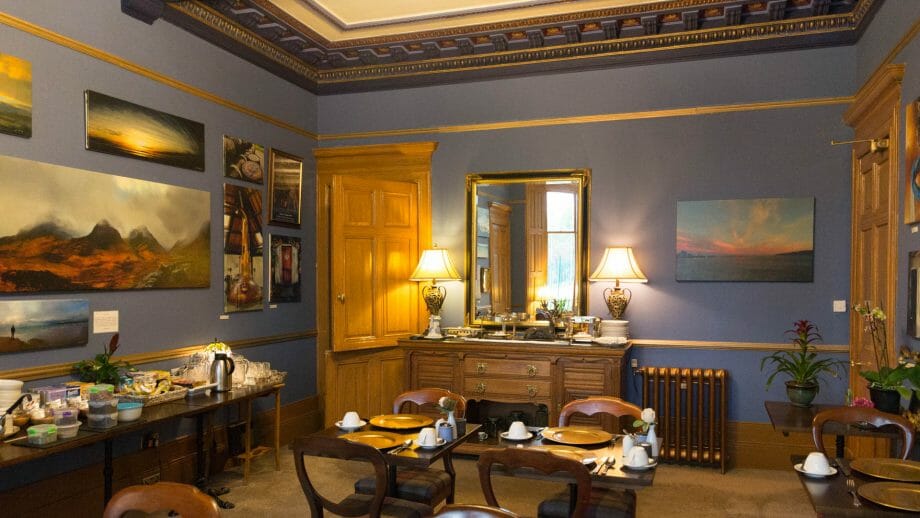
Situated at Kelvingrove Park and with wonderful facilities, this accommodation is one of the more expensive ones. We stayed here several times and were very satisfied. To get into the city, we either walked a little longer, took the bus or got on the City Sightseeing Bus, which stops three minutes away.
Here to the Alamo Guest House (advert)
ibis Styles Glasgow Central
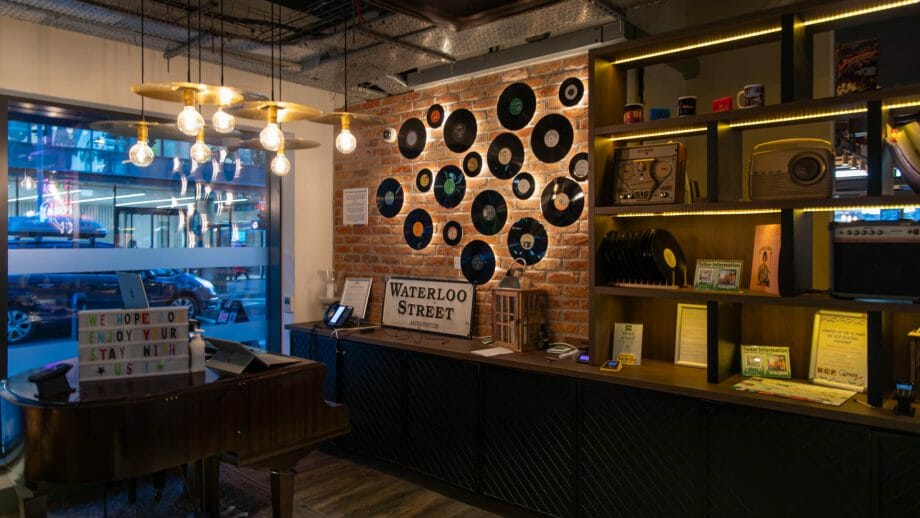
The ibis Styles is also in the mid-price segment. This boutique hotel picks up on the theme of music in Glasgow. It is located in the “Blythswood Hill” neighbourhood, in an area with many new buildings. It takes 15 minutes to walk to George Square.
Here to the ibis Style Hotel (Advertising)
Novotel Glasgow Centre
A typical Novotel, it was clean and solid.
Here to the Novotel (Advertising)
What others have already booked:
The Belhaven Hotel
This guest house is located in the West End near the botanical gardens. It is in the lower price range and lavishly furnished in a classic style.
Here to the Belhaven Hotel (advert)
Many more accommodations at Booking.com
You can find a list of accommodation in Glasgow on the Booking.com website.(Link and map widget are adverts)
[borlabs-cookie id=”booking” type=”content-blocker”]
Booking.com (function(d, sc, u) { var s = d.createElement(sc), p = d.getElementsByTagName(sc)[0]; s.type = ‘text/javascript’; s.async = true; s.src = u ‘?v=’ ( new Date()); p.parentNode.insertBefore(s,p); })(document, ‘script’, ‘//aff.bstatic.com/static/affiliate_base/js/flexiproduct.js’);[/borlabs-cookie]
Public transport: Explore Glasgow
Airport transfer: The Airport Express, number 500, takes you easily from Glasgow Airport to the city centre and costs around £8 one way, £12 return. Discounts are available for families and children.
Alternatively, you can book a transfer with a chauffeur, which is worthwhile for groups under certain circumstances. It can also be pre-booked via GetYourGuide here (advert).
In the city: Glasgow is the only Scottish city with a metro line, and has had one since 1896, when it was still a cable railway and was electrified in the 1930s. Glasgow was very early to introduce the underground railway in Europe. Only London, Istanbul and Budapest opened their underground railway lines earlier.
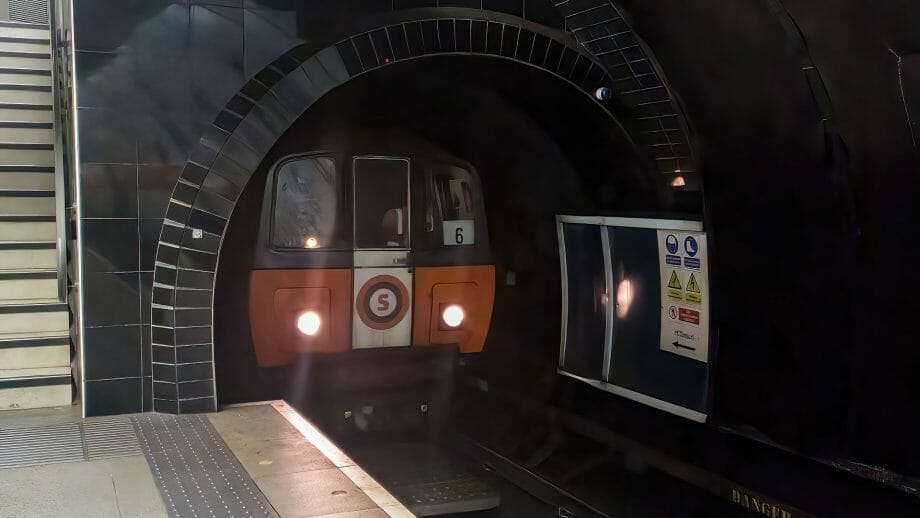
Today, the subway will take you once around the city centre of Glasgow – making it an excellent means of transport for visitors. It is operated by Strathclyde Partnership for Transport (SPT), which also runs several bus routes past the underground stations. There are also other bus companies that travel across the city. The best-known is certainly SimplyCity, which has a well-developed network. A competitor is Glasgow CityBusses, which travels a little further out.
The Scottish Railway also connects the suburbs and more outlying districts of the city with many lines that terminate at either Central Station or Queen Street Station. Both are located right in the city centre.
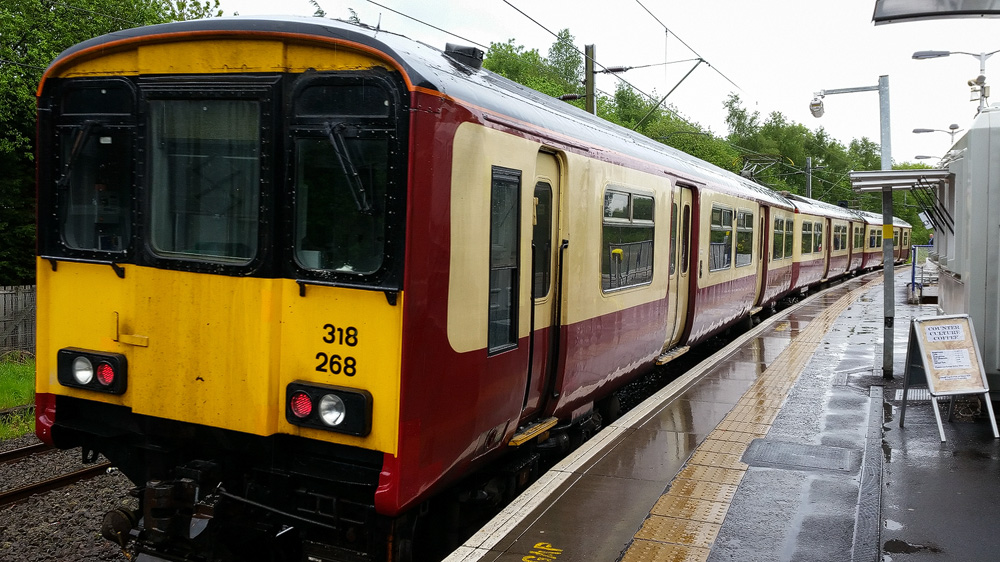
👉 TIP: City Sightseeing Glasgow Hop-on/Hop-off Bus (advert) travels clockwise around the city’s main sights and stops at each of them. The tour starts directly at George Square, the centre of Glasgow, first travels to the west, then passes George Square again before the bus continues to the east. Tours depart approximately every 20 minutes.
To get an overview and as an introduction, I can really recommend this tour. The ticket is initially quite expensive at £17.50 (as of 2018), but it’s worth it if you buy the two-day ticket, which costs just under £20, and then use it to travel from sight to sight the next day.
Dialect: Glaswegian or Glasgow Patter
Glasgow’s inhabitants have developed a marvellous linguistic melange to which Irish, Highlanders and Lowlanders have contributed. however, “Glaswegian” or “Glasgow Patter” officially belongs to “Scots”, the language of the Lowland Scots.
Words like “a wee bit” for “a little bit” are the least of the obstacles to understanding. However, when a true citizen of Glasgow gets going, the German visitor can no longer keep up with his school English.
You can watch a short course in Glaswegian here:
History of Glasgow
Founded by St Mungo
A successful city needs a good founding legend. Preferably a saint. St Mungo provides this legend for Glasgow. Around 600 AD, he is said to have worked in the area around the River Clyde. He is said to have performed three miracles: He is said to have brought a dead robin back to life and started a fire with a frozen hazel branch.
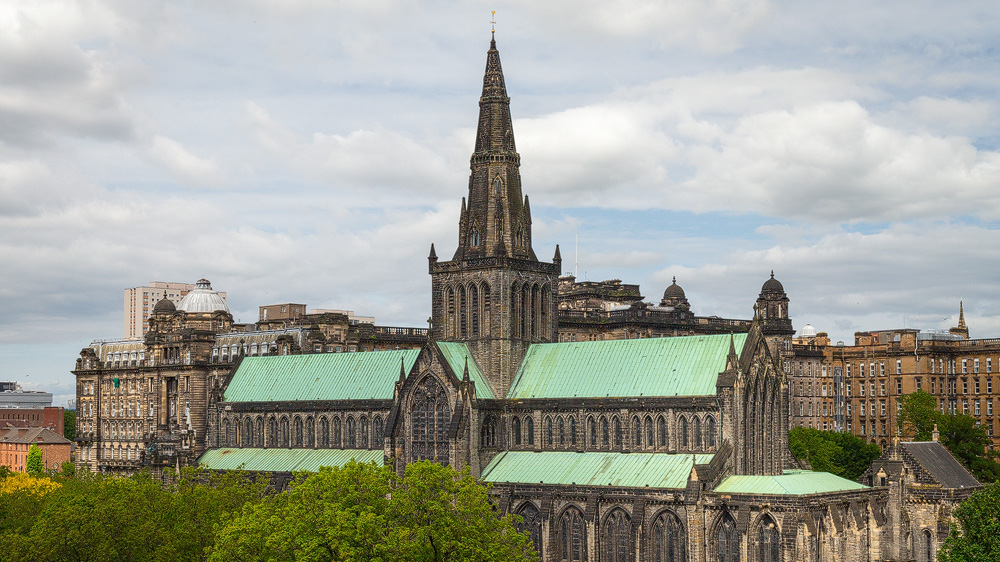
The third miracle had to do with Queen Languoreth of Cadzow – Cadzow is about 20 kilometres south-east of Glasgow in South Lanarkshire. Her king gave her a ring, which she gave to a knight. The disgruntled husband stole the ring and threw it into the Clyde. He then threatened his queen that he would kill her if she could not show him the ring. The queen turned to St Mungo for help. He ordered his disciples to fish the Clyde and bring him the first catch. No sooner said than done. Mungo took the first fish and it promptly had the ring in its mouth. The queen was saved.
Apart from working miracles, St Mungo also set up a diocese near the small river Molindar. He is said to have received a bell for his church from the Pope himself. This is where St Mungo died and where he was buried. Today, the Molindar flows underground past the Necropolis and the former bishop’s seat is now St Mungo’s Cathedral.
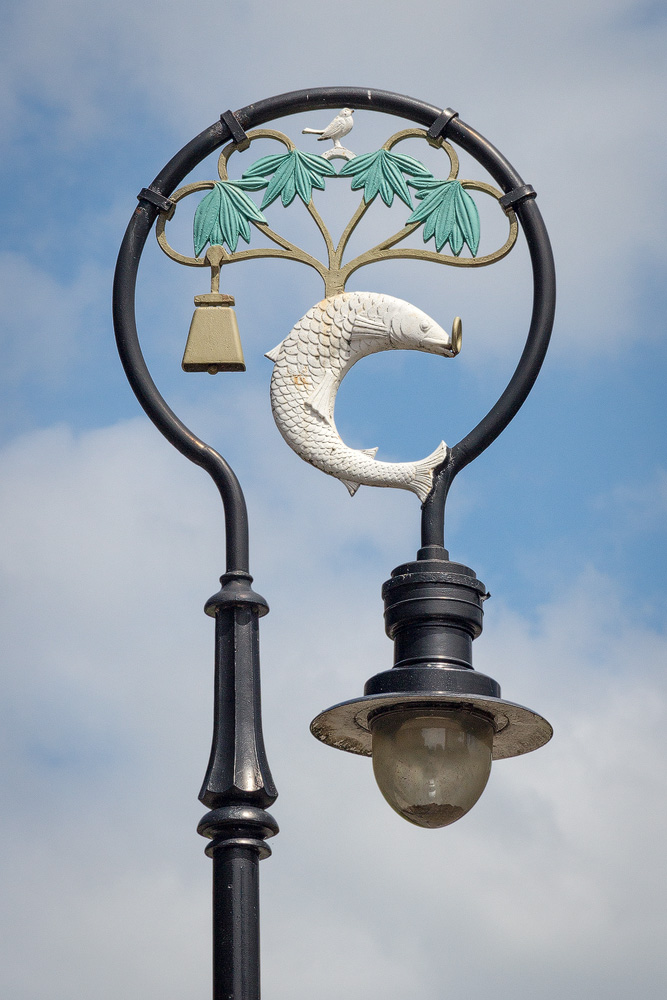
All the stories about Mungo are reflected in Glasgow’s coat of arms. At the top is Mungo himself, then comes the robin sitting on the tree (the tree stands for the hazel bush), at the roots of which lies the fish with the ring in its mouth. These symbols can also be found on the street lamps around St Mungo’s Cathedral.
There are also the matching lines:
Here is the bird that never flew
Here is the tree that never grew
Here is the bell that never rang
Here is the fish that never swam.
Incidentally, Mungo was only the saint’s nickname. In the southern climes of the British Isles, he is known as Kentigern.
Rise in the Middle Ages
The settlement of St Mungo grew along the Molindar Burn down to the River Clyde, where it soon joined up with the fishing settlements there. Further population centres were formed by road junctions. One of the most important developed where the Mercat Cross stands today.
Mercat stands for the marketplace that developed here and the names of the streets Saltmarket and Trongate still refer to this. The first comes from the salting of salmon with salt, the second “trone” refers to a scale. The ending “-gate” has nothing to do with any city gates – Glasgow never had a city wall – but simply refers to a street. It is probably closely related to the German “Gasse”. It should be clear where the Gallowgate then led … to the gallows.
In the 16th and 17th centuries, the area around today’s Mercat Cross was the booming centre, and the Tolbooth Steeple – the tower that can still be seen today – dates back to this time. However, it used to be part of a building for customs, administration and more.
The market cross with the unicorn statue on it, on the other hand, dates back to 1930 – so it’s not very old.
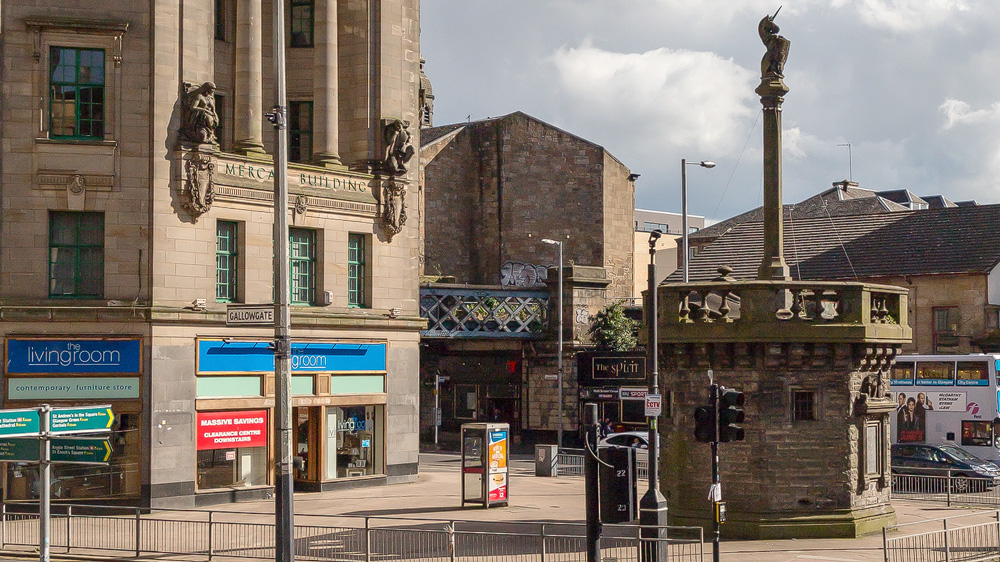
The rise of the merchants
in 2014, Glasgow was the only major city to vote in favour of Scottish independence in the referendum. The unity between England and Scotland once brought the city a boom. In 1603, the Scottish King James VI was also crowned King of England. This personal union enabled Scottish merchants to expand into the English market. And when the two kingdoms were united in 1707, this also opened up access to previously purely English colonies.
As a result, the North Sea with its harbours in the east was suddenly no longer important, but the Atlantic in the west as a waterway to America – in short: Glasgow benefited.
Glasgow’s businessmen capitalised on the new opportunities, trading mainly in tobacco and sugar. The city’s star continued to rise over the following decades, and today’s Merchant City neighbourhood with its buildings bears witness to the wealth of the tobacco lords. However, bars and cafés have now taken up residence in the former market and warehouse buildings, as can be seen in Merchant Square , for example:
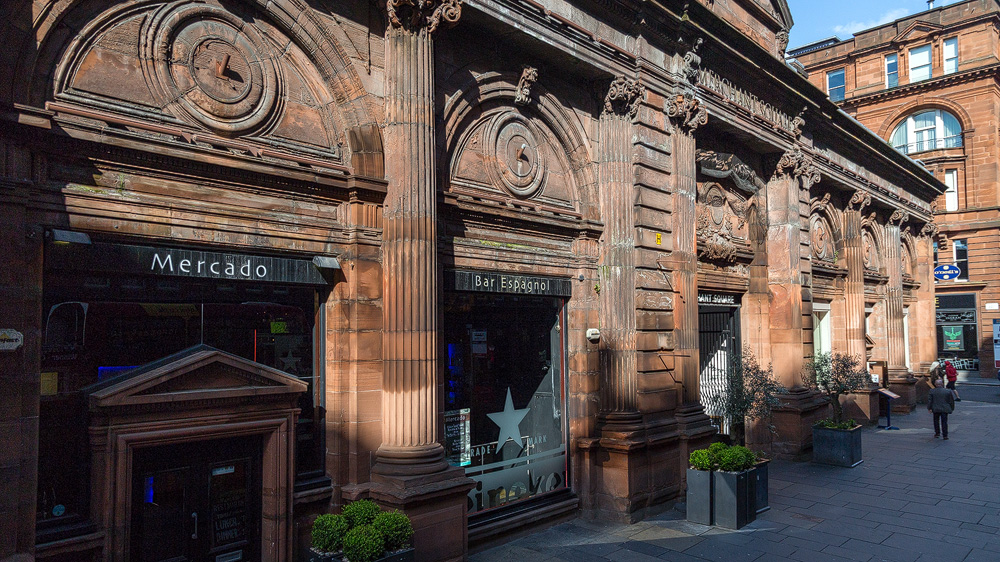
Where there is money, there is power: the rich merchants have always been able to influence the city’s rulers. Many of the decisions that characterise Glasgow’s appearance today can be traced back to this. Two catastrophic fires in 1652 and 1677 had shown how dangerous wooden houses were. So wooden houses were also banned at the instigation of the merchants – for safety reasons. And so Glasgow soon acquired the reputation of a “stone splendour”.
However, Glasgow had one problem: the River Clyde was not deep enough for modern cargo ships. Incoming goods therefore had to be unloaded further out in the Clyde estuary. However, the towns there, such as Greenock, charged high fees for this.
The “Tabacco Lords” of Glasgow were keen to save money. As early as 1668, they leased land near Newark – around 30 kilometres west of Glasgow – and had port facilities built on it. By 1710, this was already the main transshipment centre for goods in the Clyde. Newark quickly became “Port Glasgow”.
Nevertheless, the deepening of the River Clyde was also driven forward. Previously, the river had been too shallow for ocean-going ships. And so these were unloaded in Port Glasgow several kilometres away. From 1770, however, the Clyde was made navigable and Glasgow itself became an important port – and later not only a port, but also a centre for shipbuilders.
All this prosperity caused the population to grow: in 1780 there were over 42,000 people living in Glasgow, by 1801 there were 77,000 and by 1821 it had almost exploded to 147,000 – overtaking Edinburgh.
The industrial revolution
The invention of the steam engine set the industrial revolution in motion and Glasgow was one of the centres that benefited from it. The year 1811 was to establish a whole new branch of industry in Glasgow. It was in this year that the engineer Henry Bell had a paddle steamer built. It was not his idea, there were predecessors. But Bell managed to establish the “Paddlesteamer Comet” a year later as the first commercially successful steamship. Around 20 years later, 60 of these boats were already plying the Clyde, all built in and around Glasgow. by 1864, there were already 20 shipyards on the Clyde. Suppliers of boilers and materials were grouped around them, with raw materials coming from the hinterland, for example via the Forth-Clyde Canal from Falkirk.
Glasgow became one of the world’s shipbuilding centres.
Today, only one of these ships can still be seen on the Clyde. The Waverley is the last functional and seaworthy paddle steamer. It is moored in front of the Museum of Science, but also runs regular tours along the west coast of Great Britain.
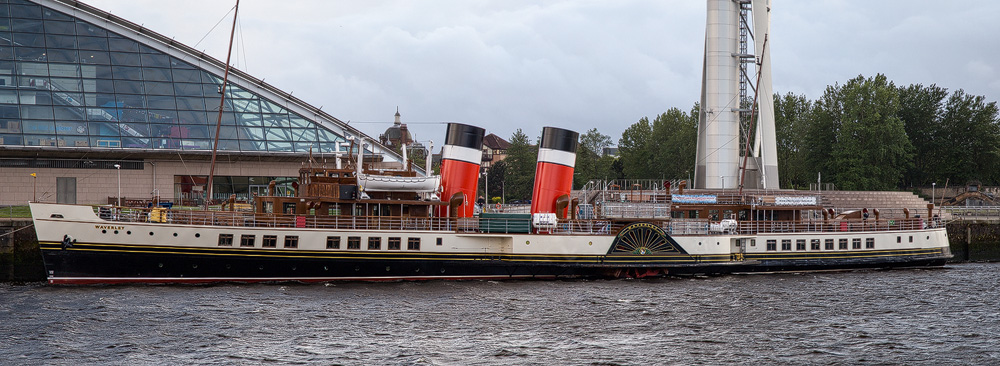
Shipbuilding was followed by the construction of locomotives, which in turn were transported to their buyers by ship. Cranes such as the impressive Finnieston Crane were erected to load the vehicles, which weighed tonnes. Glasgow soon became known for its heavy industry – and its quality.
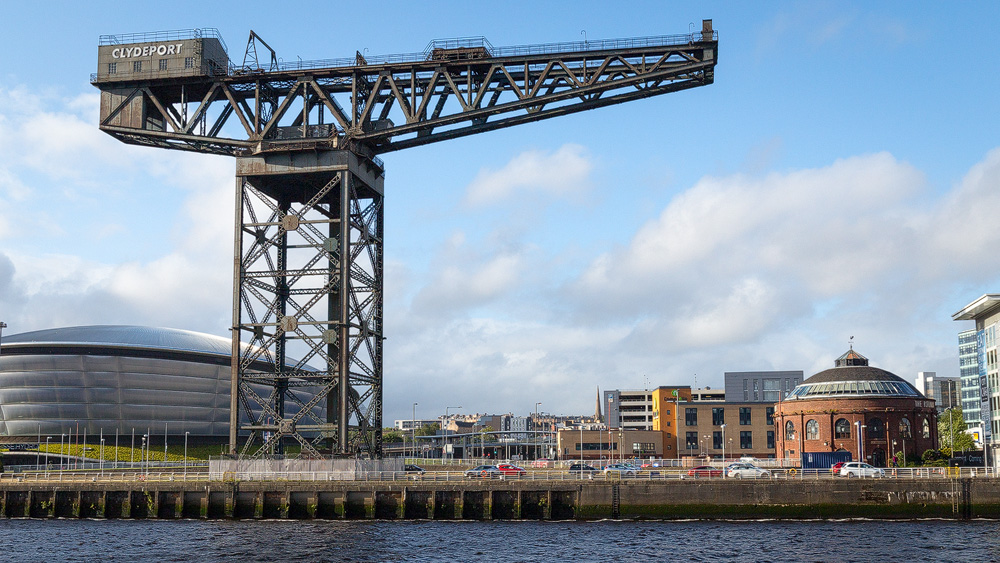
There was work. Glasgow was therefore a popular destination for immigrants. Most of them came from Ireland. And then, of course, from the Highlands and Islands of Scotland. Land was needed there for sheep farming and so many rural inhabitants were resettled or expelled. This inglorious era will later go down in the history books as the Highland Clearances.
A Gaelic-speaking community emerged, which lived scattered across the city’s neighbourhoods but met under the Central Station bridge. Today it is known as Hielanman’s Umbrella. New arrivals were usually helped here – no one was “left out in the rain”.
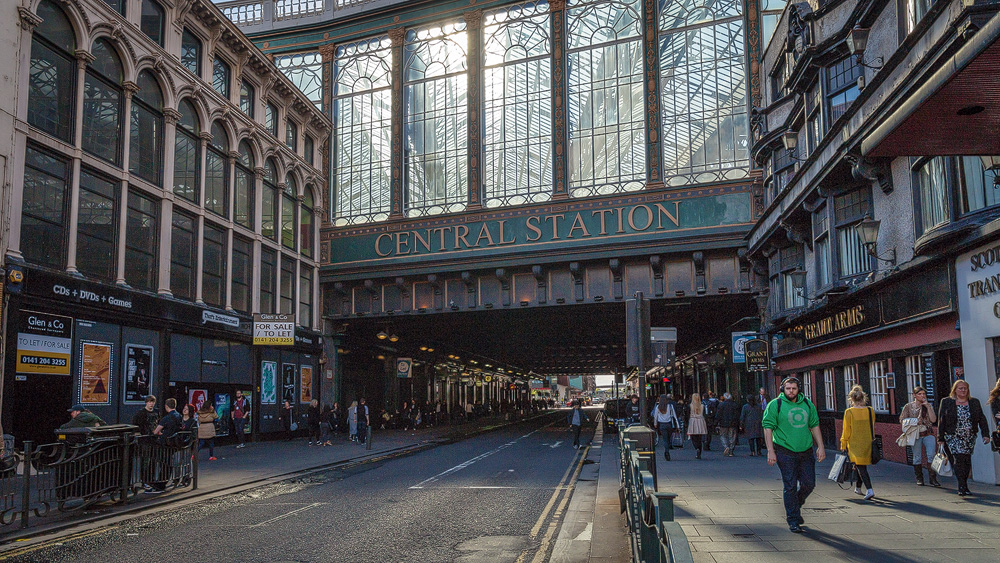
Population growth during the Industrial Revolution was followed by impoverishment of the lower classes, exacerbated by occasional economic crises. Poor housing and a lack of supplies favoured infectious diseases. Smallpox claimed countless lives, mainly children. Typhoid and cholera epidemics raged at the beginning of the 19th century.
The city authorities countered all of this with a health programme, which also provided drinkable water, for example. Nevertheless, the overall condition of the lower classes remained poor. And that did not change quickly.
Glasgow in the 20th century
The Great Depression and two world wars only exacerbated the city’s problems. The problem of the slums in particular was only slowly tackled by those in power: although the situation improved somewhat thanks to the expansion of the city area and resettlement, even in the 1950s almost half of all flats were still overpopulated. Many neighbourhoods were dirty and a haze of exhaust fumes hovered over the entire city.
The administration now began to equalise the problem. They built skyscrapers and built satellite towns like Easterhouse. They relocated a large part of the population there. Although this was good for Glasgow overall, the suburb of Easterhouse, for example, is now a hotspot for gang crime. And at the turn of the millennium, Glasgow was the city with the most murders in Western Europe.
However, Glasgow did not sink into depression because of this, but worked its way up, launching an image campaign in the 1980s called “Glasgow’s better”. The city hosted various festivals and exhibitions.
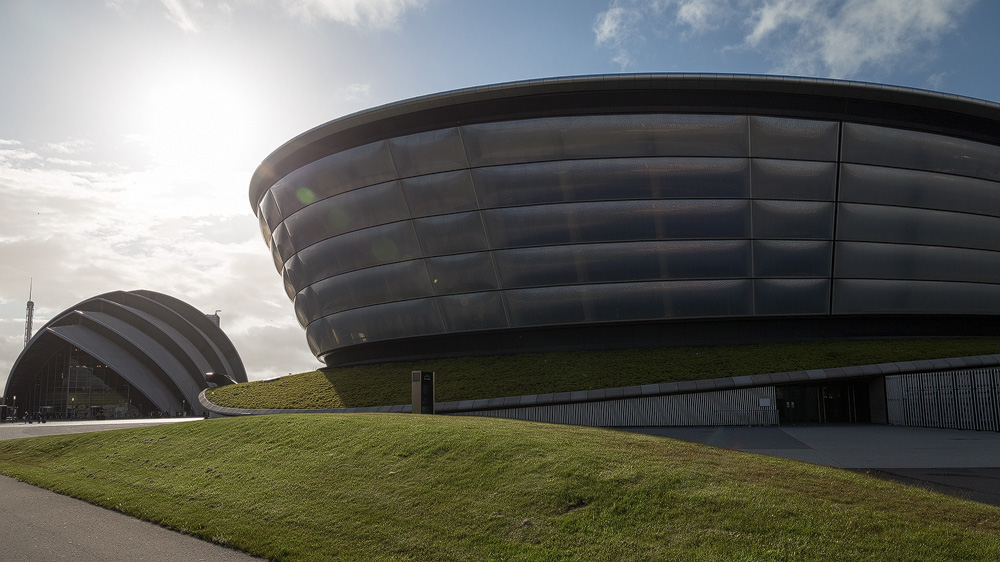
Glasgow today
The new millennium is off to a good start for Glasgow. Crime, for example, is increasingly being brought under control, thanks to the Violence Reduction Unit. The number of murders has been halved.
In addition, prestige architectural projects were gradually added to the Clyde Waterfront: the Glasgow Science Centre in 2001, the Transport Museum in 2011 and the SSE Hydro Arena in 2013. And finally, the 2014 Commonwealth Games provided a further boost.
Incidentally, the many walls painted with athletes also date from this period. The city commissioned the artist Sam Bates, also known as “Smug”, to do this. The “murals”, as they are called in English, can now be seen all over the city, but have long since moved away from the sports motif. One of the funniest, for example, is the pub scene in Argyle Shopping Street:
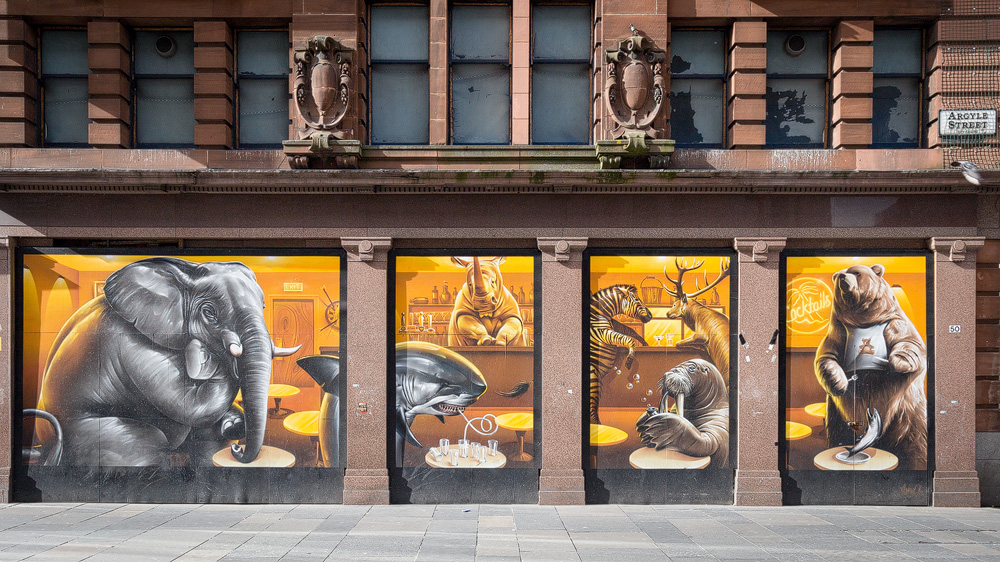
However, there are several other murals scattered across the city.
Glasgow has come a long way since the beginning of the millennium. And today, this honest and up-and-coming city is well worth a visit.